Bright services
Hubspot portal review, haal alles uit je hubspot licentie, laat je inspireren, hubspot nieuwsbrief, op de hoogte blijven van het laatste hubspot nieuws, welkom bij bright, join the bright side, wij zoeken volop a-spelers.


Wat is de buyer journey?
De buyer journey is het proces dat een potentiële klant doorloopt op weg naar een aankoop. Het belangrijkste uitgangspunt hierbij is dat de behoeften en vragen van de koper veranderen tijdens de verschillende fasen van dit koopproces.
Het buyer journey model komt voort uit de content marketing en is later ook geadopteerd in de inbound marketing methode .
Waarom het buyer journey model?
In inbound marketing hebben we een nobel streven: de potentiële klant in -iedere fase- van het koopproces optimaal vooruit helpen. Het in kaart brengen van de buyer journey ondersteunt dit proces.
De behoeften en intentie van een lead veranderen in iedere fase van de buyer journey. In de beginfase is de koper vooral aan het oriënteren en is er geen commerciële intentie. Naarmate het koopproces vordert, wordt de behoefte richting een concrete oplossing steeds concreter en neemt de commerciële intentie toe.
We helpen de buyer persona (representatie van jouw ideale klant) dus optimaal vooruit wanneer we onze content aanpassen aan -en matchen met- de fasen van de buyer journey. Zo komt vraag en aanbod perfect overeen en ontstaat er harmonie.

Buyer journey fasen
We onderscheiden in de buyer journey de volgende fasen:
Awareness - bewustwordingsfase
De awareness fase wordt in het Nederlands ook wel de bewustwordingsfase genoemd. In deze fase van de buyer journey wordt de potentiële klant zich bewust van een probleem, of de mogelijkheid tot het benutten van een kans.
Aan het begin van deze fase is dit bewustzijn nog niet of nauwelijks aanwezig. Daarom is het belangrijkste doel in deze fase om de klant bewust te maken van de aard en omvang van het probleem (of de aard en omvang van de mogelijke kans).
De behoefte van de buyer persona is in deze fase vooral: informatie inwinnen en meer leren over het probleem (of het benutten van de kans).
Content is daarom in deze fase niet commercieel van aard. Over het product of dienst wordt (nog) niet geschreven. De content concentreert zich rondom alle facetten van het probleem, zodat het bewustwording bij de potentiële koper groeit.
Consideration - overwegingsfase
In de consideration fase van de buyer journey heeft de potentiële klant het probleem gedefinieerd en afgebakend en gaat hij/zij op zoek naar oplossingsrichtingen.
In Nederland wordt deze fase de overwegingsfase genoemd omdat de buyer persona verschillende oplossingsrichtingen overweegt in de fase.
De behoefte van de buyer persona is in deze fase al een stuk concreter. Het probleem is bekend en afgebakend. Nu is het tijd om alle ins & outs te onderzoeken. Een deep dive dus.
De content is in deze fase gematigd commercieel. De nadruk ligt nog steeds op het oplossen van het probleem, of het benutten van de kans. Denk bijvoorbeeld aan het proces of de methodiek (hoe) in plaats van puur het product of dienst (wat).
Decision - beslissingsfase
In de decision fase neemt de buyer persona de beslissing voor een oplossing en vindt dus de aankoop plaats.
Ook hier wordt er in Nederland een vrij directe vertaling gehanteerd, namelijk: de beslissingsfase.
De behoefte van de buyer persona ligt in deze fase compleet bij specifieke oplossingen. Verschillende producten en/of diensten worden in detail onderzocht en met elkaar vergeleken.
Content is in deze fase van de buyer journey gefocust op het product of het in gebruik nemen van het product. Denk in de b2b bijvoorbeeld aan het implementatieproces en de impact en gevolgen daarvan. Zo dicht op de aankoop, is de koper tevens op zoek naar bevestiging van het nemen van de juiste beslissing. Om deze reden worden er vaak case studies en/of testimonials ingezet om de klant te overtuigen.
Promoter - klantfase
De laatste fase van de buyer journey is de fase waarin jouw klant je product en/of dienst actief gebruikt. HubSpot noemt deze fase de promoter fase omdat het ultieme doel van inbound marketing is dat klanten ambassadeurs worden van je bedrijf en/of merk.
Andere marketingspecialisten bekijken deze fase meer vanuit het perspectief van de klant en noemen het de service of support fase. Dit is met name een b2b perspectief omdat veel b2c producten geen service of support fase kennen.
De behoefte van de klant ligt in de klantfase rondom het beter gebruiken van de oplossing.
Goede content vervult deze behoefte. Denk aan handleidingen om het product efficiënter of effectiever te gebruiken, of content in de support sfeer, zoals een serviceportaal of FAQ pagina’s.
Buyer journey vs customer journey
Er is veel verwarring over het verschil tussen de buyer journey en de customer journey. Dit is niet heel vreemd, want de woorden lijken al op elkaar, maar ook qua inhoud zijn er overeenkomsten.
Het korte (maar onvolledige) antwoord is:
- De buyer journey focust op potentiële klanten (leads) en hun koopproces.
- De customer journey focust op klanten en hun ervaring met het bedrijf, product en/of dienst.
Niet twee journeys, maar één
Door de jaren heen kwamen er echter nieuwe inzichten en is de scheidingslijn tussen de buyer journey en de customer journey vervaagd. Zo heeft Avinash Kaushik van Google het See (Awareness), Think (Consideration), Do (Decision), Care (Promotor) model in het leven geroepen en voegen ook steeds meer andere marketingexperts de klantfase(n) toe aan het buyer journey model.
Wanneer je dit alles vanuit het oogpunt van de klant bekijkt, is het niet meer dan logisch om één model te hanteren. Voor de klant is er één doorlopende “reis”, niet twee afzonderlijke.
Bij Bright Digital adviseren we daarom om één journey model te hanteren. Dit is klantgericht en pragmatischer dan twee afzonderlijke. Of je dit buyer journey of customer journey noemt, dat laten we aan jou over ;-). Als het eindresultaat maar is dat je jouw klant keer-op-keer optimaal van dienst bent.
“De term ‘customer’ (in customer journey) is eigenlijk niet goed gekozen, want ook potentiële klanten behoren tot de reis die leidt tot de aanschaf van een product of dienst.” - Bart van de Kooi, De Customer Journey in kaart in 60 minuten.
Het kan echter wel een zinvolle exercitie zijn om de klantfase uit te diepen. Een klant wordt niet zomaar van ene op de andere dag een promoter namelijk. Om je een idee te geven van dit proces, verwijzen we naar de customer fasen in het boek: ‘ De customer journey in kaart in 60 minuten ’ (ook in dit boek één reis van potentiële koper naar klant).
De klantfasen die in dit boek uitgediept worden, zijn:
- Leveringsfase bij een b2b project bijvoorbeeld de implementatieperiode.
- Gebruiksfase waarin de klant het product actief gebruikt.
- Loyaliteitsfase waarin loyaliteit ontstaat. Eerst transactioneel, daarna emotioneel.
- Ambassadeursfase waarin klanten reclame maken voor jou en je bedrijf promoten.
De rol van marketing automation
Marketing automation helpt je niet bij het in kaart brengen van de buyer journey, maar het helpt je wel in de uitvoeringsfase.
Zoals je hebt gelezen is het streven van inbound marketing om leads en klanten optimaal te helpen in iedere fase van de buyer journey. Dit betekent dat je ze de juiste content (passend bij de buyer journey fase) aanbiedt op het juiste moment. Dit noemen we lead nurturing . Met marketing automation bereik je dit en is dit proces tevens onbeperkt schaalbaar.
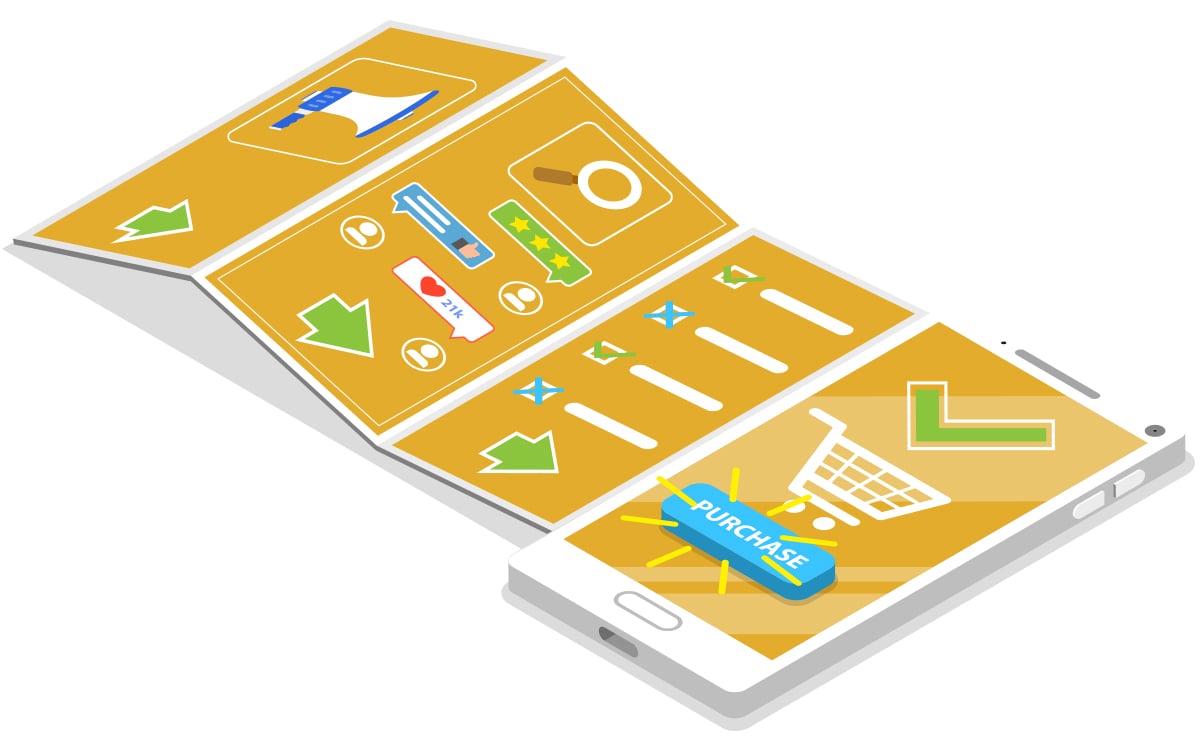
Tips buyer journey in kaart brengen
We sluiten af met een paar gouden tips op het gebied van buyer journey mapping:
Link een buyer journey altijd aan één buyer persona
Een buyer persona is een realistische afspiegeling van jouw ideale klant. Deze buyer persona heeft een bepaalde rol in de organisatie die bepalend is voor een groot deel van het handelen. Om deze reden is een buyer journey altijd gelinkt aan één bepaalde buyer persona.
Stel bij je buyer persona onderzoek ook buyer journey vragen
Bij een buyer persona onderzoek interview je klanten en leads om inzicht te krijgen in onder meer: hun doelen, behoeften, problemen en angsten. Alleen dan ben jij in staat om content te (laten) schrijven die perfect aansluit bij de behoeften van je potentiële klant.
Waarom zou je deze gelegenheid niet gebruiken om meer te leren over hun koopreis? Structureer daarom het interview naar het buyer journey proces. Begin met vragen over de bewustwordingsfase en vervolg met vragen over de overwegingsfase en de beslissingsfase. Interview je een klant? Stel dan ook vragen die betrekking hebben op de klantfase van de buyer journey.
Op deze manier krijg jij niet alleen inzicht in de behoeften van de klant, maar krijg je inzicht in de behoeften van de klant in relatie tot de buyer journey.
Doe zoekwoorden onderzoek
Zoekwoorden onderzoek wordt vaak -geheel onterecht- gekoppeld aan zoekmachine marketing. Een dergelijk onderzoek biedt ook inzichten in de vraag en het terminologiegebruik van de buyer persona.
Veel zoekwoorden hebben een intentie die duidelijk te linken is aan één specifieke buyer journey fase. Wanneer iemand bijvoorbeeld zoekt op ‘ Wat is SEO? ’ dan is het duidelijk dat het om een informatiebehoefte gaat in de bewustwordingsfase. Googelt iemand op ‘ inbound marketing bureaus vergelijken ’ dan zit hij/zij waarschijnlijk in de beslissingsfase. Ook de klantfase is gemakkelijk te herkennen. Wat denk je bijvoorbeeld van de zoekopdracht ‘ handleiding Hubspot workflows ’, of ‘ Hubspot Academy ’?
Verwerk de buyer journey in inbound marketing campagnes
Wanneer de buyer journey helemaal in kaart is gebracht, weet jij welke behoeften jouw potentiële klanten hebben en wanneer ze dat hebben (in welke fase van het koopproces).
Gebruik deze kennis. Schrijf content die toegewijd is aan de behoeften van één buyer persona in één bepaalde buyer journey fase. En zorg dat je voor iedere fase in de buyer journey content hebt die de lead vooruit helpt.
Zet vervolgens marketing automation in om de content op het juiste moment aan te bieden aan je leads en klanten.
Lees verder over buyer persona’s
Buyer persona’s en de buyer journey zijn onlosmakelijk verbonden. Uitleg, tips en advies hierover vind je op onze buyer persona pagina .
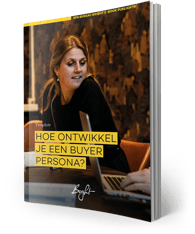
Advies nodig?
Heb je na het lezen van deze pagina vragen? Of wil je eens vrijblijvend brainstormen met een van onze inbound marketing consultants? Schroom dan niet.

Bright Digital is dé partner voor bedrijven die versneld willen groeien met HubSpot
Vosselmanstraat 300 7311 VV Apeldoorn Bekijk locatie Bel +31 85 - 760 8181
Prins Bernhardplein 200 1097 JB, Amsterdam Bekijk locatie Bel +31 85 - 760 8181
Stay connected
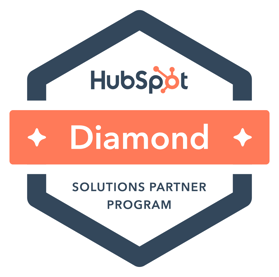

Iedere woensdag om 12:00 een nieuwe online marketing hack gratis in je inbox.
Het koopproces en de buyers journey | Uitleg & Tips
Wat is een buyers journey.
Een buyers journey is een weergave van alle stappen die een klant zet voordat deze overgaat tot kopen. Niet iedere klant zal het gehele koopproces doorlopen en het proces zal voor iedere klant verschillen.
Door de buyers journey in kaart te brengen kun je via de marketing de juiste acties inplannen.
B2B buyers journey
Binnen de B2B duurt het koopproces (over het algemeen) wat langer. Er zijn meerdere beslisslagen en er wordt langer gedaan over een koopbeslissing.
B2B sales is dan ook in het algemeen een stuk complexer.
B2C buyers journey
Binnen de B2C zie je dat het koopproces over het algemeen juist snel gaat. Marketing ligt vooral op de massa en veel van de aankopen worden op impuls of op basis van herhaling gemaakt. De klant kende het bedrijf al en hoeft niet meer overtuigd te worden.
Aan de slag met jou Buyers Journey
De reis van de koper is het proces dat kopers doorlopen om zich bewust te worden van een nieuw product of dienst, deze te evalueren en te kopen.
Een buyers journey is anders dan een customer journey .
Een customer journey gaat over de reis van de klant. Er wordt omschreven hoe iemand klant is geworden, hoe ze bekend zijn geraakt met het bedrijf en hoe er met bestaande klanten wordt omgegaan.
De 4 fases binnen de Buyers Journey
Kijken we naar het buyer journey model dan wordt er gebruikgemaakt van 3 fases. Bewustwording, overweging en beslissing.
Wij werken liever met 4 fases.
Omdat dit jou veel beter helpt om de complete reis in kaart te brengen. Uiteindelijk gaat het er ook niet om dat je mooie buyers journey in kaart brengt, maar om je marketing en verkoopstrategieën beter af te stemmen.
1 | De bevestiging
Bevindt jouw klant zich nog in de bevestigingsfase, dan zit deze nog aan het begin van het koopproces. Er is een probleem of behoefte geconstateerd en eigenlijk weet je nog niets.
Je klant heeft wel een behoefte of probleem waar hij iets mee wil doen, maar laat nog geen gedrag zien.
Inspelen op de bevestigingsfase is lastig, al dan niet onmogelijk.
Wil je inspelen met je marketing op de allereerste fase, verdiep je dan in het brein van je klant.
Denk na over de situatie waarin je klanten zich bevinden voordat zij behoefte krijgen aan jouw product of dienst.
Hoe je dit doet, leg ik je uit in de video.
2 | Informatie zoeken
Bevindt jouw klant zich in de informatiefase, dan laat hij het gedrag zien om van zijn probleem af te willen komen.
Er wordt naar oplossingen gezocht, er worden vragen gesteld en men bereidt zich voor op de volgende fase in het koopproces: het evalueren van de alternatieven.
Onderzoek hoe jij jouw potentiële klanten helpt met het geven van de juiste informatie.
Bekijk blogs, reviews en forums van je concurrenten om te achterhalen welke vragen er worden gesteld.
Hoe meer inzicht je hebt, hoe beter je in staat bent je marketing hierop aan te passen.
Zorg dat je nadenkt welke informatie iemand wenst, denk na over de juiste marketingstrategie en bepaal wat de meest logische vervolgstap is.
3 | Evaluatie
Bevindt jouw klant zich nog in de evaluatiefase, dan bevindt hij zich behoorlijk ver in het koopproces. De klant is bijna klaar om te kopen.
Er dient nog een keuze gemaakt te worden.
De klant bekijkt alle mogelijke oplossingen voor zijn probleem of alle verschillende mogelijkheden om in zijn behoefte te voorzien.
De klant is klaar voor de volgende stap, maar moet nu eerst een keuze maken.
Een keuze tussen jou of je concurrent.
Hoe voorkom je dat je van jouw concurrent verliest?
Wees beter.
Waarom bang zijn voor je concurrenten wanneer je je klanten kunt helpen kiezen?
Een klant vergelijkt toch wel. Hoe belangrijker de uitgave of keuze, hoe belangrijker ons brein het vindt om een weloverwogen keuze te maken.
Of we uiteindelijk daadwerkelijk een weloverwogen keuze hebben gemaakt is de volgende vraag, maar gevoel moet er zijn.
Laat mensen de vergelijking maken. Niet iedereen zal je klant worden en dat hoeft ook niet. Toon je klanten of ze WEL of juist NIET bij jou passen.
Denk na over wat jou een geschikte partij maakt.
Help je klanten verder in het koopproces. Laat ze een vergelijking maken tussen jouw dienst en die van je concurrent of intern in je assortiment.
Verkoop je meerdere producten of vergelijkbare diensten, help je klant kiezen.
De laatste fase van de buyers journey is het daadwerkelijk kopen.
Wil je jij je marketing richten op deze laatste fase in het koopproces, bedenk dan wat een klant nodig heeft, of juist tegenhoudt, om de koopbeslissing te maken.
Welke obstakels kan iemand hebben?
Bedenk hierbij eerst de obstakels die iemand kan ervaren over het product of de dienst zelf. Heb je deze obstakels weggenomen, neem dan de obstakels weg die bij jouw bedrijf passen.
Hoe zit het met je levertijd, regio, garanties etc. Gooi alles in de strijd om de laatste obstakels weg te nemen en de klant voor jou te winnen.
De verkooptechnieken voor het complete koopproces
Voor iedere fase zul je andere verkooptechnieken moeten gebruiken. Verdiep je in het brein van je klant als je écht klanten wilt werven .
Denk bij iedere fase wat de klant nodig heeft om hem verder te helpen in het koopproces.
Test wat werkt, werk met A/B testen en maak kleine aantekeningen tijdens je verkoopgesprek . Blijf onderzoeken en testen wat werkt.
Zet jij je vol in, maar blijft het resultaat uit?
Voelt het alsof je alle trucs al hebt geprobeerd? Blogs doorspitten, eindeloos video’s bekijken, podcasts op repeat – en toch, geen steek verder.
Herkenbaar?
Misschien mis je wel die ene gouden tip die alles op zijn kop zet.
Ik snap het helemaal.
Zelf heb ik me 15 jaar geleden een weg gebaand door de jungle van ondernemen. Jarenlang worstelen, experimenteren, falen en weer opstaan. Tot ik de sleutel vond. Die sleutel? Die draaide mijn tweede onderneming van een bescheiden start-up naar een bloeiend coachbedrijf verspreid over heel Nederland.
Nu, met meerdere succesvolle bedrijven op mijn naam sta ik hier. Als jouw gids in de online marketing en business wereld, klaar om jou door dat doolhof te leiden.
👉 Online Marketing & Business Coaching Terwijl we strategisch aan je bedrijf werken laten we het internet al het harde werk doen.
👉 Online Marketing Advies Ik help je jouw visie te vertalen naar een concreet, winnend online marketingplan.
👉 De Sw!tch Speciaal voor coaches, adviseurs en trainers die klaar zijn voor de grote sprong. Dit programma is jouw ticket uit de sleur, door dat plafond heen, rechtstreeks naar het succes dat je verdient.
Krijg de brutaalste marketing tips iedere week gratis in je inbox.
- Herman Kuijkstraat 52 Geldermalsen
- 085 303 3950
- Marketing & Business Coaching
- Online marketing advies
- De 5 Sleutels voor 100K
What Is the Buyer's Journey?
Updated: July 21, 2022
Published: April 21, 2021
Today's buyer is more informed than ever before, thanks to the vast amount of information available at their fingertips. Because of this, the balance of power has shifted from the sales rep to the buyer in most sales conversations . This is why pushy sales tactics are no longer effective the way they used to be.

Instead, to be successful in sales in today's day and age, sales reps must adapt their mindset from selling to helping . And the best way to start this process is becoming intimately familiar with who the buyer is and the journey they take on their path to purchase : The buyer's journey .
hbspt.cta._relativeUrls=true;hbspt.cta.load(53, '12501f7c-8e26-4e3c-9642-7afbe078156a', {"useNewLoader":"true","region":"na1"});
What is the buyer's journey.
The buyer's journey describes a buyer's path to purchase. In other words, buyers don't wake up and decide to buy on a whim. They go through a process to become aware of, consider and evaluate, and decide to purchase a new product or service.
By understanding the buyer's journey , the pains and problems they experience along that journey, and the influencing factors that shape their thinking, sales reps can better empathize with the buyer and position their product or service along that path. So let's dig in a little further.
What are the three stages of the buyer's journey?
The buyer's journey can be broken down into three steps or "stages" that describe how they advance along their path to purchase: the awareness stage, the consideration stage, and the decision stage.
Here's how to conceptualize each stage:
- Awareness Stage: The buyer becomes aware that they have a problem.
- Consideration Stage: The buyer defines their problem and considers options to solve it.
- Decision Stage: The buyer evaluates and decides on the right provider to administer the solution.

Now that the overall journey has been defined, let's take a look at each stage in greater detail, from the buyer's perspective:
.webp)
Free Customer Journey Template
Outline your company's customer journey and experience with these 7 free templates.
- Buyer's Journey Template
- Future State Template
- Day-in-the-Life Template
You're all set!
Click this link to access this resource at any time.
What is the buyer doing during the awareness stage?
The buyer is experiencing a problem or symptoms of a pain, and their goal is to alleviate it. They may be looking for informational resources to more clearly understand, frame, and give a name to their problem.
- Example: "Why do my feet hurt all the time?"
What is the buyer doing the consideration stage?
The buyer will have clearly defined and given a name to their problem, and they are committed to researching and understanding all of the available approaches and/or methods to solving the defined problem or opportunity.
- Example: "How do you treat arch pain?"
What is the buyer doing during the decision stage?
The buyer has decided on their solution strategy, method, or approach. Their goal now is to compile a list of available vendors, make a short list, and ultimately make a final purchase decision.
- Example: "Where can I get custom orthotics? How much will they cost?"
If you don't have an intimate understanding of your buyers, it may be difficult to map out the buyer's journey in a way that will be helpful from a sales perspective. In this case, be sure to conduct a few interviews with customers, prospects, and other salespeople at your company to get a sense of the buying journey.
Tailoring Your Sales Process to the Buyer's Journey
With all of this in mind, buyers don't want to be prospected, or demoed, or closed when they're not ready. These steps add zero value, from their perspective, when offered at the wrong time.
However, where a sales rep can shine is in the instances when buyers are looking for additional information about your product that can't be found online.
Free Customer Journey Map Templates
Fill out the form to access these visual aids., awareness stage.
Buyers are identifying the challenge or opportunity they want to pursue. They are also deciding whether or not the goal or challenge should be a priority.
Consideration Stage
Buyers have clearly defined the goal or challenge and have committed to addressing it. They are now evaluating different approaches or methods available to pursue the goal or solve their challenge.
Decision Stage
Buyers have already decided on a solution category and are now evaluating providers. For example, they may have written a pro/con list of specific offerings to decide on the one that best meets their needs.
Some of these considerations may fall more under the marketing umbrella than the sales umbrella, but ultimately the answers to these questions will provide a robust foundation for your buyer's journey.
The process of getting to know how your buyers buy is invaluable as you create or refine your sales process. You'll be better able to empathize with prospects, handle objections, and provide the right information at the right time, helping you close more deals and win more business.
Thank you for reading this post from HubSpot .
Editor's note: This post was originally published in October 2018 and has been updated for comprehensiveness.
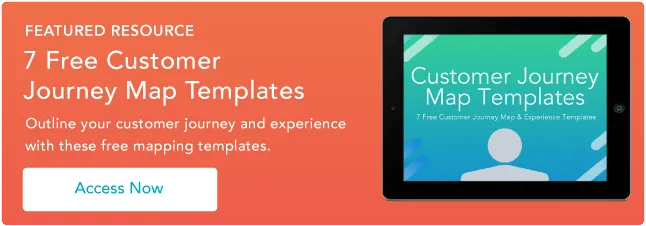
Don't forget to share this post!
Related articles.

7 Crucial Questions to Ask Prospects Throughout the Buyer's Journey, According to HubSpot's Sales Director

The 8 Buyer Motives Every Salesperson Should Know

How to Win More Sales With An Optimized Distribution Strategy
![buyers journey uitleg What the Buyer's Journey Looks Like in 2022 [+3 Data-Driven Ways You Can Keep Up]](https://blog.hubspot.com/hubfs/buyers%20journey%20%281%29-1.jpg)
What the Buyer's Journey Looks Like in 2022 [+3 Data-Driven Ways You Can Keep Up]

B2C Sales: A Comparison With B2B and How to Do Them Right
![buyers journey uitleg How to Craft Tailored Recommendations For Prospects [Free HubSpot Sales Training Excerpt]](https://blog.hubspot.com/hubfs/00-Blog_Thinkstock_Images/how-to-advise-prospects-video.jpg)
How to Craft Tailored Recommendations For Prospects [Free HubSpot Sales Training Excerpt]

9 Ways Salespeople Can Provide Value to Prospects at Every Stage of the Buyer’s Journey
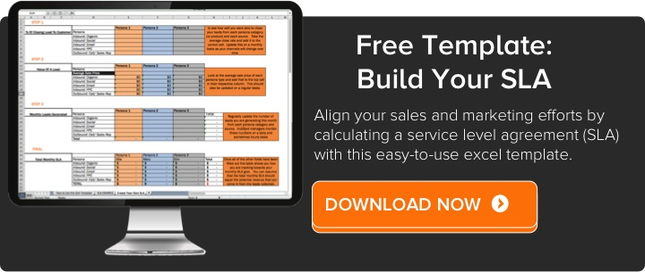
When To Use Customer Case Studies in the Sales Process
Outline your company's customer journey and experience with these 7 free customer journey map templates.
Powerful and easy-to-use sales software that drives productivity, enables customer connection, and supports growing sales orgs
- Case studies
- Expert advice
What is the buyer journey? Definition, stages, and examples
Step into the realm where choices weave the intricate fabric of consumer decisions — the buyer journey. As we navigate this landscape, we'll uncover the definition, stages of such a journey, and real-world examples that demystify the process.
Join us on this expedition — no fluff, just the essential roadmap to unravel the buyer journey and decode the patterns that drive purchasing decisions.
Ready to explore the journey that transforms curiosity into commerce? Let's unravel the layers together.
- 1.1 Why is the buyer journey important?
- 2 Buyer journey stages
- 3 Buyer journey optimization
- 4.1 Amazon and its seamless e-commerce experience
- 4.2 HubSpot and its inbound marketing excellence
- 4.3 Buyer journey templates
- 5.1 Key takeaways
What is the buyer journey? Why is it important?
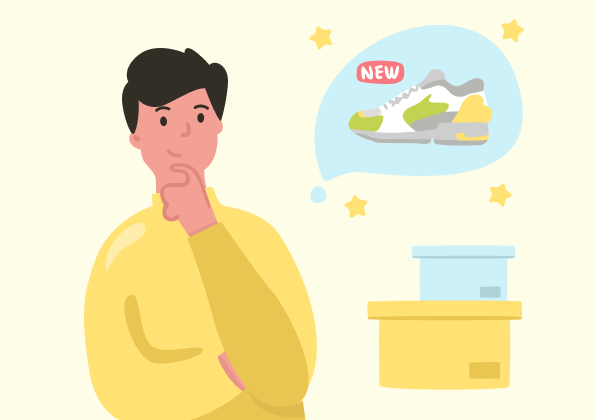
The buyer journey represents the holistic path a buyer takes as they move through the various stages leading to a purchase. It’s a comprehensive process that encapsulates the entirety of a customer's experience, from the initial awareness of a product or service to the final decision-making and post-purchase evaluation. The depth and complexity of such a journey are heightened by the fact that it can be online, offline, or a mix of both. Here are the examples:
- Online journey: A customer discovers a digital product through a targeted social media ad, researches online reviews, and makes a purchase on an e-commerce website. Post-purchase, they use the online product and engage with the brand through email newsletters and online customer support.
- Offline journey: A customer learns about a product through a traditional print advertisement, visits a physical store to explore the item, consults with in-store staff, and makes the purchase. The post-purchase phase involves using the product and potentially providing feedback through physical channels.
- Mixed journey: A customer first encounters a product via an online influencer's review, then visits a brick-and-mortar store to examine it physically. They might purchase online using a mobile app, receiving post-purchase updates through both email and in-store promotions.
Why is the buyer journey important?
Understanding the buyer journey is of paramount importance for businesses for many reasons.
- Customer-centric approach
By comprehending the buyer journey, businesses can adopt a more customer-centric approach. It means aligning products, services, and digital marketing efforts with the needs and preferences of the customers at each journey stage . This customer-centricity fosters a positive and engaging experience, enhancing the likelihood of conversion.
- Tailored marketing strategies
The buyer journey provides businesses with insights into the specific touchpoints and channels that customers engage with during their decision-making process. Armed with this knowledge, organizations can tailor their marketing strategies to be more effective at each stage. For instance, deploy inbound marketing and educational materials to capture attention, especially during the awareness stage.
- Building trust and credibility
Trust is a crucial element in any purchase decision. Understanding a buying journey enables businesses to build trust by delivering consistent messaging, quality content, and positive interactions at each touchpoint. This trust-building process is vital for establishing credibility and driving long-term customer relationships.
- Optimizing user experience
A seamless and enjoyable user experience is critical to guiding potential buyers through the journey. With buyer journey analysis, businesses can identify pain points and areas of improvement in their processes. This could include optimizing website navigation, streamlining checkout processes, or enhancing customer support.
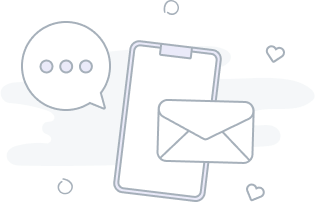
- Data-driven decision-making
The buyer journey map is a valuable source of data that businesses can use to inform their decision-making. Analyzing customer behavior, preferences, and feedback at each stage provides actionable insights. This data-driven approach enables companies to refine their strategies, allocate resources efficiently, and stay agile in a dynamic market.
- Maximizing customer lifetime value
Understanding the buyer journey goes beyond the point of purchase. Post-purchase stages of the journey, such as customer loyalty and advocacy, are crucial for maximizing customer lifetime value. Businesses that continue to engage and delight customers even after the sale are more likely to benefit from repeat business and positive word-of-mouth marketing.
In essence, the buyer journey serves as a roadmap for businesses to navigate the complex landscape of customer decision-making. It empowers companies to meet customer expectations, build lasting relationships, and ultimately drive sustainable business growth.
Buyer journey stages
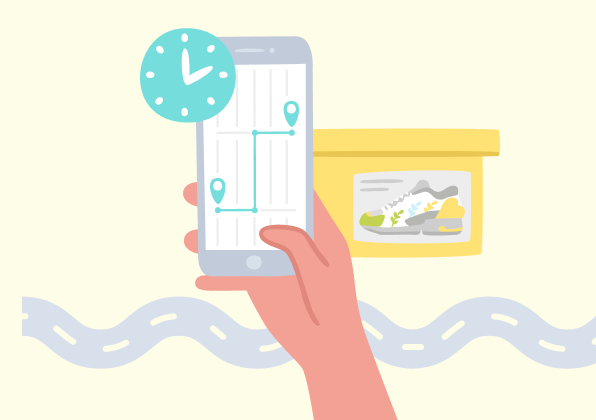
The buyer journey consists of stages a potential customer goes through before making a purchase decision. All journeys are somewhat different, but it's possible to identify broad stages common to each. Let's explore these stages in detail:
- Awareness stage
This is the initial stage where the buyer becomes aware of a problem or need. They may not be aware of specific solutions yet.
Example: Someone realizes they need a new smartphone because their current one is outdated and struggles with performance.
- Research and discovery stage
At this stage, the buyer actively seeks information to understand and define their problem. They research potential solutions and gather relevant data.
Example: The individual might explore various smartphone brands, read reviews, and compare features to find the best fit for their needs.
- Consideration stage
At this point, the buyer narrows down their options and is evaluating specific products or services. They compare features, prices, and benefits.
Example: The person may be deciding between two or three smartphone models based on factors like camera quality, battery life, and overall performance.
- Decision stage
The buyer is now ready to make a decision and commit to a particular product or service. They might look for discounts, compare final prices, and explore additional incentives.
Example: The individual decides to purchase a specific smartphone model, adds it to the cart, and proceeds to check out.
- Purchase stage
This is the point of transaction where the buyer completes the purchase. It could happen online, in-store, or through various other channels.
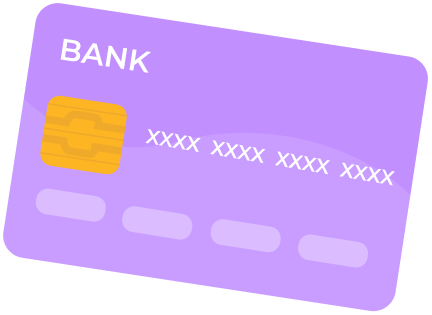
Example: The person confirms the purchase, enters payment information, and receives confirmation of the order.
- Post-purchase stages
After the purchase, the buyer uses the product or service and forms their experience about it. This stage is crucial for customer satisfaction and potential loyalty.
Example: The individual starts using the new smartphone, and their experience is positive. They might leave a review, share their experience on social media, or consider the brand for future purchases.
- Loyalty and advocacy stage
There is an additional stage focusing on turning customers into loyal advocates. This involves fostering ongoing relationships, encouraging repeat business, and leveraging satisfied customers for viral marketing. This stage is often overlooked by businesses, and it's a mistake.
Example: The satisfied smartphone user recommends the brand to friends, engages with loyalty programs, and becomes an advocate for the product.
Read also: How to create a journey map step-by-step + examples
Understanding and visualizing these stages allows businesses to tailor their marketing, sales, and customer support strategies to address customers' specific needs and concerns at each step. It helps create a more personalized and effective approach, ultimately increasing the likelihood of conversion and building long-term customer relationships.
Buyer journey optimization
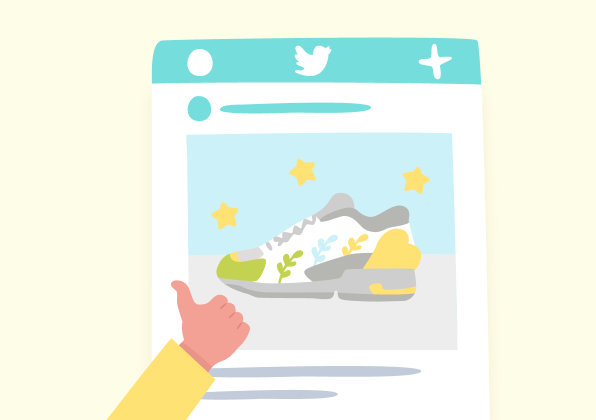
Buyer journey optimization involves refining and enhancing the various stages of the customer's path to purchase to improve overall efficiency, effectiveness, and customer satisfaction and experience.
By strategically optimizing each stage of the journey, businesses can maximize conversion rates, build stronger customer relationships, and increase long-term loyalty. Here's a detailed exploration of buyer journey optimization with examples and potential outcomes:
- Data-driven analysis
Example: A company collects and analyzes data on customer behavior, interactions, and preferences at each stage of the buyer journey using analytics tools and customer relationship management (CRM) systems.
Outcome: Insights gained from data analysis help businesses identify patterns, pain points, and opportunities for improvement in the buyer journey.
- Personalized content and messaging
Example: Leveraging data insights, a business tailors its content and messaging to match the preferences and needs of specific buyer personas at different stages of the journey.
Outcome: Personalized content increases engagement and resonates more effectively with potential customers, leading to a higher likelihood of conversion.
- Seamless multichannel experience
Example: An e-commerce platform ensures a consistent and seamless experience for customers across various channels, including online platforms, mobile apps, and physical stores.
Outcome: A unified multichannel experience reduces friction, enhances customer satisfaction, and provides a cohesive journey regardless of the chosen interaction channel.
- Optimized website and user experience
Example: A company invests in user experience design , making its website intuitive, easy to navigate, and optimized for both desktop and mobile users.
Outcome: Improved website usability enhances customer satisfaction, reduces bounce rates, and encourages visitors to move smoothly through the buyer journey.

- Marketing automation
Example: Implementing digital marketing automation tools to deliver targeted and timely messages, such as personalized emails, based on customer behavior and interactions.
Outcome: Marketing automation streamlines communication, helps to nurture leads, and ensures that potential customers receive relevant information at the right moment in time, increasing the chances of conversion.
- Streamlined checkout process
Example: An e-commerce platform simplifies its checkout process, minimizing the number of steps required and offering various payment options.
Outcome: A streamlined checkout process reduces cart abandonment rates and friction during the purchase stage, leading to higher conversion rates.
- Post-purchase engagement
Example: After a customer makes a purchase, a business engages in post-purchase communication, seeking feedback, offering support, and providing additional resources or exclusive offers.
Outcome: Positive post-purchase engagement contributes to customer satisfaction, encourages repeat business, and fosters brand loyalty.
- Continuous iteration and improvement:
Example: Regularly reviewing analytics, customer feedback, and market trends to identify areas for further optimization and adjustment in the buyer journey strategy.
Outcome: Continuous iteration ensures that the buyer journey remains responsive to changing customer needs and market dynamics, maintaining high levels of effectiveness over time.
In summary, journey optimization is an ongoing process that requires a combination of data analysis, personalization, technological integration, and a customer-centric mindset. By strategically implementing these optimizations, businesses can create a more seamless, engaging, and efficient journey for their customers, ultimately driving higher conversion rates and long-term customer loyalty.
Buyer journey examples
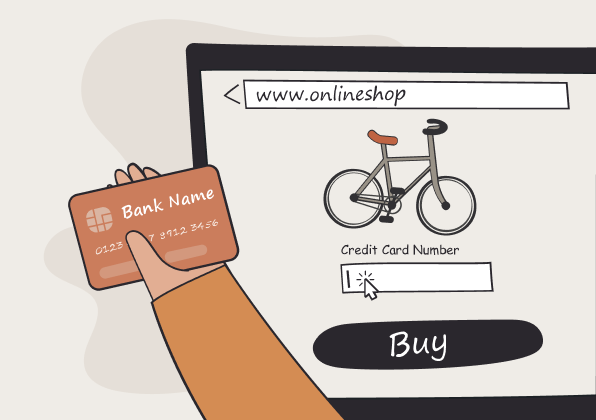
Let's consider a couple of examples of buyer journeys in well-known companies, what they do to improve it, and how it works in practice.
Amazon and its seamless e-commerce experience
Even if you don't use Amazon products, you've definitely heard about them.
Amazon excels in creating awareness through targeted ads, personalized recommendations, and a vast product catalog. For example, if a user searches for a specific product, Amazon's algorithms provide relevant suggestions, increasing the chances of discovery.
The product pages on Amazon are rich in information, featuring detailed product descriptions, customer reviews, and frequently asked questions. This assists customers in making informed decisions during the research stage.
Amazon leverages personalized recommendations and targeted emails to remind users about products they viewed or added to their cart. Special promotions, such as lightning deals, create a sense of urgency, influencing the decision-making process.
The one-click purchase option streamlines the decision-making process, offering a frictionless checkout experience. Amazon's transparent shipping and return policies contribute to the customer's confidence in their decision.
- Post-purchase stage
Amazon invests in post-purchase engagement through order tracking, delivery notifications, and follow-up emails. Additionally, their customer service is readily available to address any issues, enhancing post-purchase satisfaction.
HubSpot and its inbound marketing excellence
HubSpot is a comprehensive inbound marketing, sales, and customer service platform designed to help businesses attract, engage, and delight customers. And they do delight.
HubSpot built a robust online presence through inbound marketing. Their blog, webinars, and downloadable resources provide valuable information, attracting businesses looking for marketing and sales solutions.
HubSpot offers free tools, such as CRM and marketing analytics, allowing users to explore and understand the platform's capabilities before making a commitment. Their educational content assists businesses in the research stage.
HubSpot's sales team engages with potential customers through personalized email outreach, offering product demonstrations, and addressing specific pain points. This approach helps businesses evaluate HubSpot's fit for their needs.
HubSpot's pricing transparency and scalable solutions cater to businesses of different sizes. They provide flexible payment options and a clear onboarding process, making it easier for businesses to decide.
HubSpot focuses on customer success through continuous education, regular updates on new features, and a vibrant community. They encourage users to maximize the platform's potential, fostering long-term loyalty.
These examples showcase how companies like Amazon and HubSpot strategically engage with customers at each stage of the buyer journey, leading to successful conversions and sustained customer relationships.
Buyer journey templates
Visual aids can often speak louder than words. Therefore, here are some templates for various scenarios. They'll be a great asset to your initiative.
- Case 1: A bicycle buyer journey, where a potential buyer, filled with excitement and a quest for the perfect bicycle, navigates the online realm in search of their two-wheeled companion.
- Case 2: An offline grocery buyer journey, where our persona embarks on the classic journey to the neighborhood supermarket, weaving through aisles in search of sustenance and delights.
- Case 3: A sneakers' buyer journey, where a persona sets out to find the ideal pair of sneakers, exploring the vast world of online options and paving the way for stylish strides.
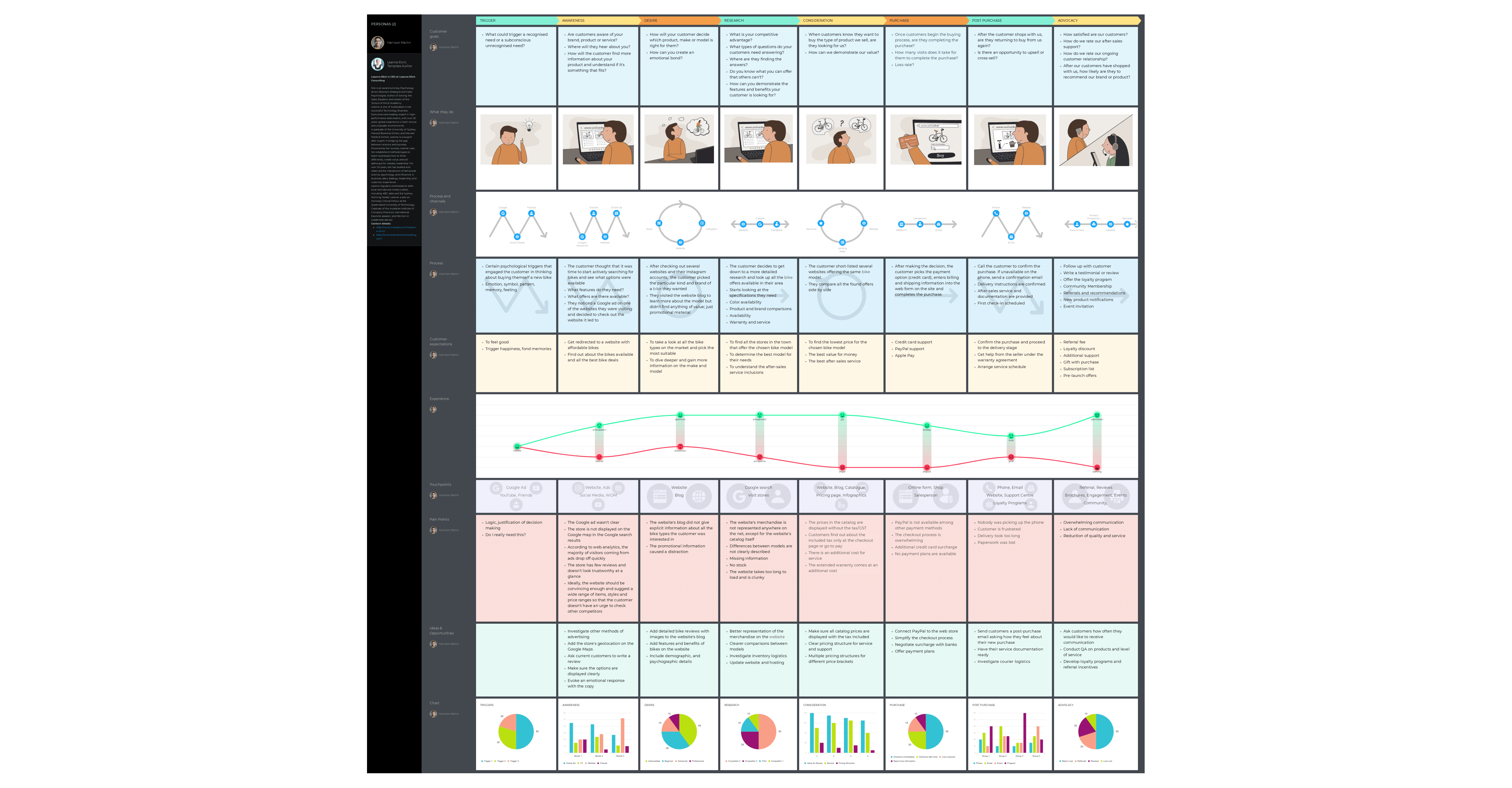
Wrapping up
In unraveling the complexities of the buyer journey, we've delved into its definition, stages, and real-world examples. This journey is not merely a linear path from awareness to purchase; it's an intricate process that demands a nuanced understanding of customer behavior.
Key takeaways
- Businesses must align products, services, and marketing efforts with customer needs at each stage, fostering positive and engaging experiences.
- Analyzing the buyer journey provides valuable data for refining strategies, optimizing user experiences, and staying agile in a dynamic market.
- Building trust through consistent messaging, quality content, and positive interactions is crucial for establishing credibility and fostering long-term relationships.
- The journey doesn't end with a purchase; positive post-purchase experiences contribute to customer satisfaction, loyalty, and advocacy.
- Buyer journey optimization is an ongoing process involving data analysis, personalization, technological integration, and a customer-centric mindset.
As we navigate the ever-evolving landscape of consumer decisions, understanding and effectively leveraging the buyer journey is not just a strategy; it's a fundamental approach that can drive sustainable business growth. So, let's continue to unravel the layers of this intricate journey, adapting and refining our strategies to meet the ever-changing needs of our customers.
Related posts
Rate this post
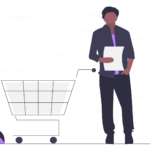

Close more deals with the latest sales trends and tips from Salesblazers.
What Is the Buyer’s Journey — and Why Should You Care About It?
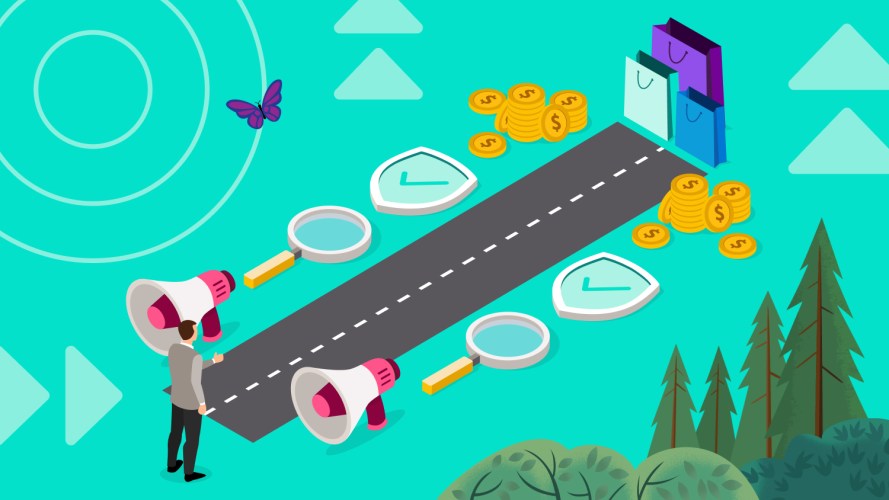
Learn how to map out your buyer's journey to improve the path to purchase.

Erin Hueffner
Share article.
Today’s buyers are more informed than ever. In fact, 81% of reps say customers are conducting their own research before they ever connect with sales. Canned scripts and one-size-fits-all methods won’t cut it when dealing with savvy buyers — they want more detailed information, more personalized solutions, and a tailored sales approach. That’s why it’s so critical to understand the buyer’s journey. Once you know what a prospect needs to move from interest to purchase, you navigate the sales road with ease and close quickly.
Here’s how you get there.
What you’ll learn:
What is the buyer’s journey, what are the stages of the buyer’s journey, why is understanding the buyer’s journey important, how does the buyer’s journey relate to the lead funnel, how to tailor your sales process to the buyer’s journey, buyer’s journey example, drive pipe faster with a single source of truth.
Discover how Sales Cloud uses data and AI to help you manage your pipeline, build relationships, and close deals fast.

The buyer’s journey accounts for all the steps a customer takes to move from discovery for a product to purchase. This includes their behaviors and attitudes toward your brand and how they interact with your marketing and, eventually, your product or service.
This journey is typically segmented into three stages: awareness, consideration, and decision. Don’t assume, however, that every buyer steps through those three stages in 1-2-3 order every time. Buyers’ journeys often wind up taking very non-linear paths. We’ll get into that below.
As noted above, the buyer’s journey can be summed up in three stages. Each stage factors in the psychological state of the buyer, including their needs, behaviors, and decision-making processes. These help inform the actions a seller can take to move the deal forward. Let’s take a closer look at each one:
Awareness stage
Buyers at the awareness stage want something that solves a problem or meets a need, but they don’t know exactly what that is. They start to gather information about solutions, but this information is driven by knowledge of a specific product, service, or brand. Typically, this research involves online research or conversations with others dealing with similar problems/needs.
Tip: At this stage, it’s all about making a strong and credible first impression that lays the groundwork for a relationship based on trust and value. How? By focusing on solutions. Don’t pitch a product — solve a problem. This is when your marketing content, especially on social media, can shine. Video content is a great way to answer questions, provide examples, share testimonials, and deliver in-depth information that promises a helpful solution. As part of this, you’ll want to gently introduce your product — while keeping the focus on the solution it offers, not the features it includes.
Consideration stage
As buyers move into this stage, they are actively researching, comparing, and considering different options. Online shopping and review sites, social media, and email newsletters give customers multiple channels to explore. Take advantage of these by making them next steps in the buyer journey. If you find the buyer is engaging with awareness content like a blog post, for example, create a promo for a newsletter signup in the post to encourage continued engagement.
Tip: Engage potential customers in this stage by providing detailed, comparative, and solution-focused content like blog posts and personalized emails that highlight the unique benefits and features of your offerings.
Decision stage
By now, buyers understand their problem, have done their research, and are ready to make a purchase — but they haven’t crossed the finish line yet. Everything they’ve explored up to now, including price, value, features, benefits, customer reviews, and brand reputation, will be considered and factored into their final decision. The seller’s job? Package all of these as part of the original solution the buyer was looking for.
Tip: In this crucial stage, you want to address any remaining concerns and help the buyer make a purchase decision. To overcome objections , your interactions with customers should be persuasive, reassuring, and clear. Reinforce the value and benefits of your offering. Remember: Selling a solution rather than a product can help set you apart from competitors.
Trending Articles

3 Ways Generative AI Will Help Marketers Connect With Customers

Learn AI Skills on Trailhead
More than just a throwaway sales concept, the buyer’s journey lets you see and understand the choices your buyers make at each stage of the sales process so you can meet their needs in the moment. Understanding the buyer’s journey can give you:
- Enhanced customer insights: Studying the buyer’s journey gives you a deeper understanding of your customers’ needs, pain points, and decision-making processes. This data then helps you create content and strategies that resonate with potential customers.
- Improved content strategy: By knowing what buyers think and want at each stage, you can create content that addresses specific concerns and questions. The right content can provide the guidance customers need to make informed decisions and can also help you field objections.
- Increased sales efficiency: With insights from the buyer’s journey, you can anticipate needs, counter objections quickly, and tailor pitches more effectively. You’re not just selling. You’re providing solutions and guidance at the moment the buyer is most receptive.
- Enhanced customer experience: When you anticipate and address needs at each stage of the journey, you deliver a smoother, more personalized customer experience. This not only increases the likelihood of conversion but also fosters loyalty, leading to repeat business and referrals.
Understanding the buyer’s journey is a key part of building lasting relationships with customers. It’s about moving beyond sales to build genuine connections based on trust and value and ensuring satisfaction at every touchpoint. This ultimately redounds to the seller’s benefit; with strong relationships and loyalty often come repeat sales.
The lead funnel and the buyer’s journey look at the sales process from different perspectives. The lead funnel represents the process from a seller’s or company’s perspective. It outlines the stages a seller walks through on the way to a close. In contrast, the buyer’s journey sees things from the customer’s perspective. It’s all about their experience on the path to purchase.
Aligning your sales process with the buyer’s journey ensures that you meet customer needs at each stage and can guide them toward a purchase decision without delays. Let’s combine what we’ve learned so far into actionable items:
Awareness stage actions
• Understand your audience: Identify and analyze your potential customers’ needs and behavior. Pro tip: Use your CRM to help! An AI-powered tool such as Sales Cloud Einstein can do a lot of the heavy lifting for you via prompt-based research.
• Generate awareness: Use educational content to draw prospects in and establish your brand as a credible source.
Consideration stage actions
- Provide more details product content: Offer comparative, solution-focused content that highlights your product’s benefits.
- Personalize communication: Tailor your interactions with information you’ve gathered about your potential customers.
Decision stage actions
- Address objections: Prepare your team to counter any concerns or objections with clear and compelling information.
- Simplify the purchase: Streamline the buying process, offer clear pricing, and be transparent about contracts.
Get articles selected just for you, in your inbox
The buyer’s journey is not linear. It’s a fluid relationship between brand and customer. Here’s an example that illustrates this:
Raina wants to cut down on her bills and realizes there’s an opportunity to cut down her monthly entertainment spend. Rather than pay for streaming services and cable TV, she wants something that consolidates both.
To start, Raina maps out what she wants. She lists her must-watch shows and researches which streaming platforms offer them (awareness). She narrows her choices to two platforms, including one ad-supported and one premium service. She’s also thinking about adding a live sports package but isn’t clear on which packages carry her favorite teams’ games, so she contacts the streaming service companies for more information (consideration). After chatting with several sales representatives, Raina asks for a demo of one of the service’s sports add-ons. She and the rep discuss subscription plans and go over which games will be available for streaming.
Ultimately, Raina decides to subscribe to both streaming platforms without the additional sports package (decision). Lucky for her, she’s offered a free three-month trial of the live sports add-on at sign-up. After realizing how much she enjoys the add-on in the trial period, Raina decides to keep it.
In this case, Raina’s buyer journey doesn’t end after her purchase. Her experience with the streaming services will influence how she feels about the brands and shape her future interactions with them, including future purchases.
Map to the buyer’s journey for better outcomes
If you pay close attention to the buyer’s journey and deliver high value, your customers are more likely to stay loyal and explore other products in your portfolio, which means more sales. Remember, each interaction with a prospect is an opportunity to understand, engage, and nurture. By aligning your sales process with each stage in the buyer’s journey, you can increase sales while building long-term relationships.
Want to take the #1 CRM for a test drive?
Go on our Guided Tour to see how Sales Cloud boosts productivity at every stage of the sales cycle.

Just For You
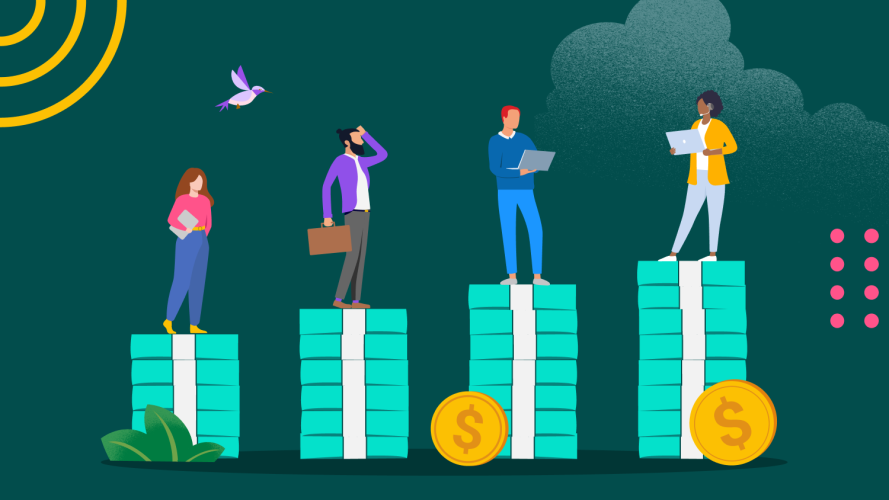
A Beginner’s Guide to Tiered Commission Structures
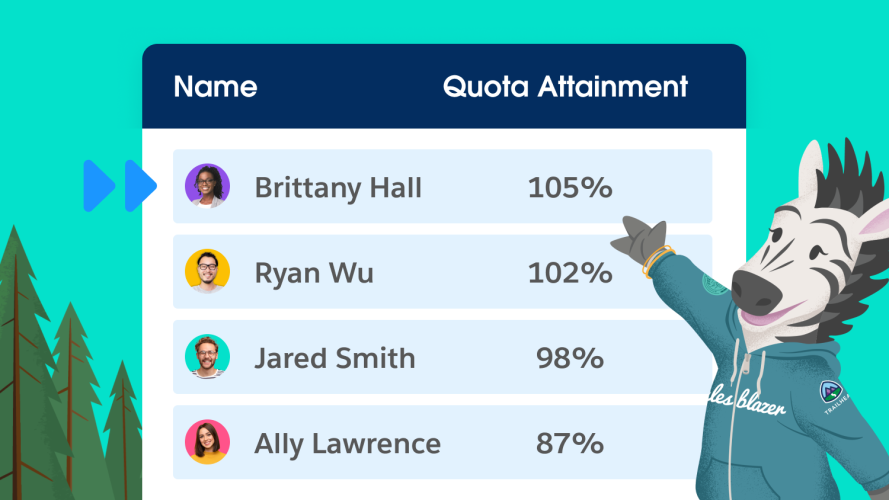
Why a Sales Leaderboard Is the Key to Team Motivation — and How to Use it Effectively

Explore related content by topic
- Sales Fundamentals
- Salesblazer

Erin Hueffner is a writer from Madison, Wisconsin. Her career spans two decades in tech, journalism, and content marketing. At Salesforce, Erin’s work focuses on sales fundamentals and best practice content for Salesblazers. Erin has a bachelor’s degree in English from the University of Wisconsin-Madison.
Get the latest articles in your inbox.

AI From A to Z: The Generative AI Glossary for Business Leaders
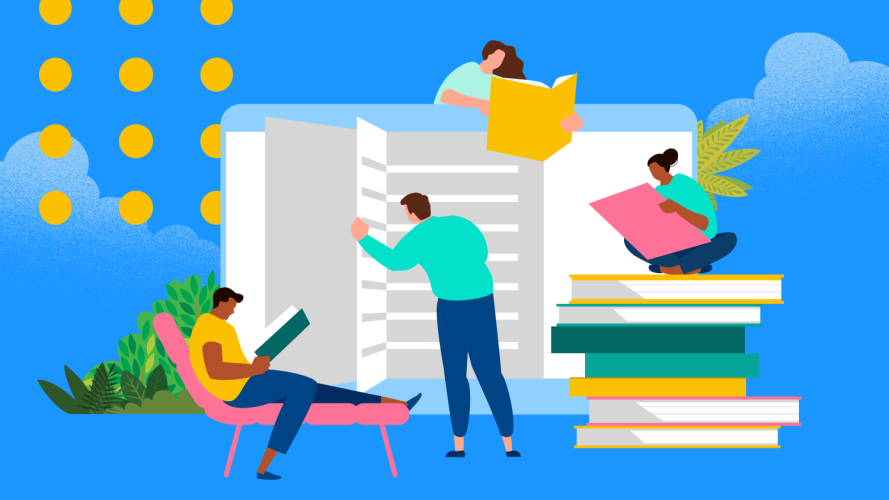
Chicken Soup for the Quota: 12 of the Greatest Sales Books Ever Written
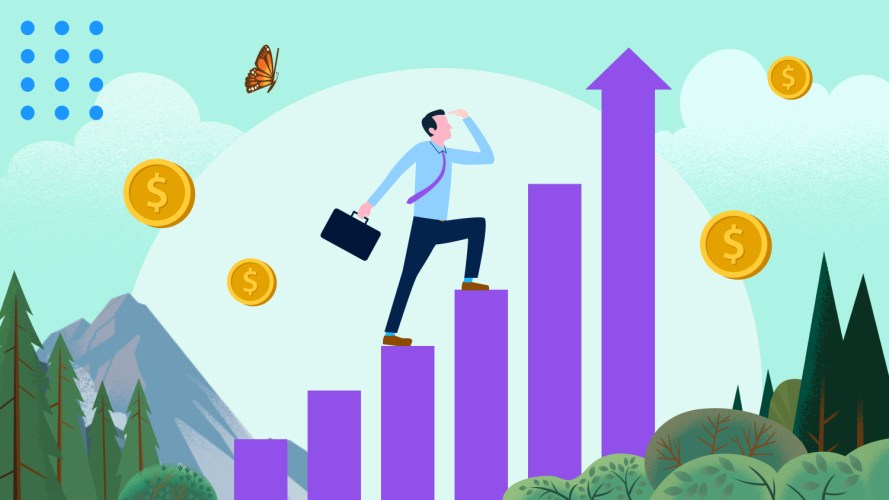
Uncapped Earnings: The Benefits of Limitless Commission
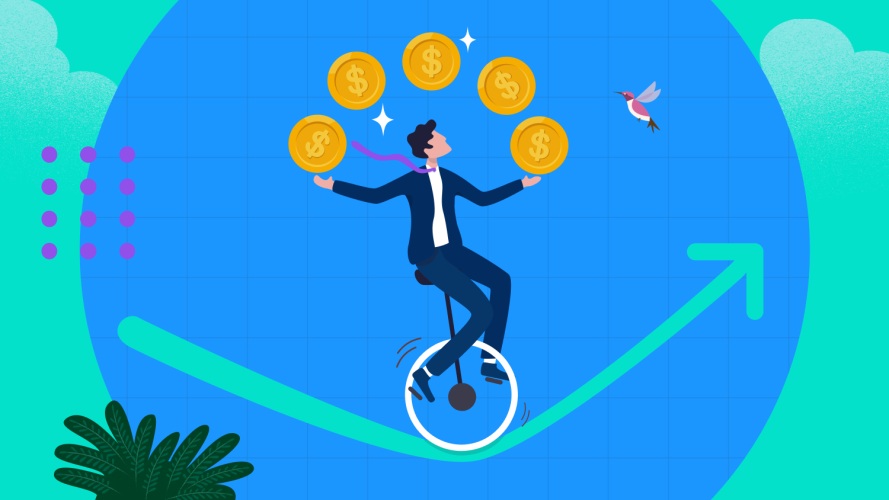
A Close Look at At-Risk Pay and the Purpose Behind Performance-Based Compensation
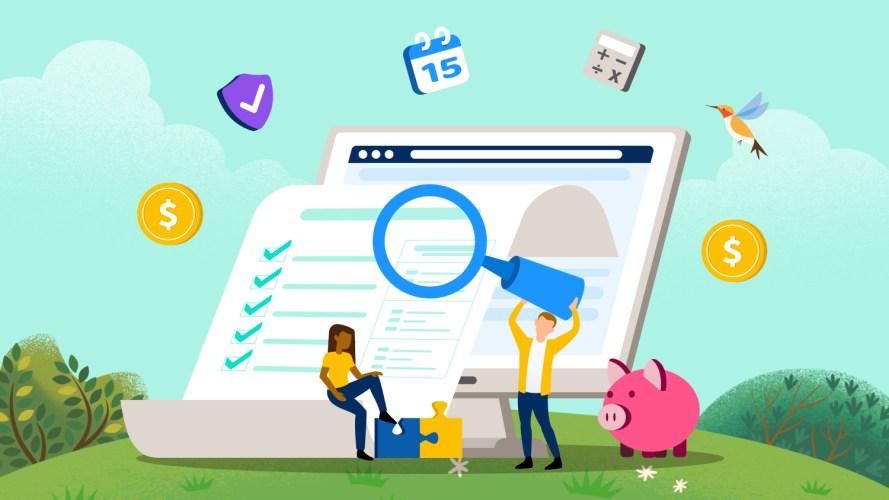
How Presales Sets the Stage for Your Team’s Next Big Deal
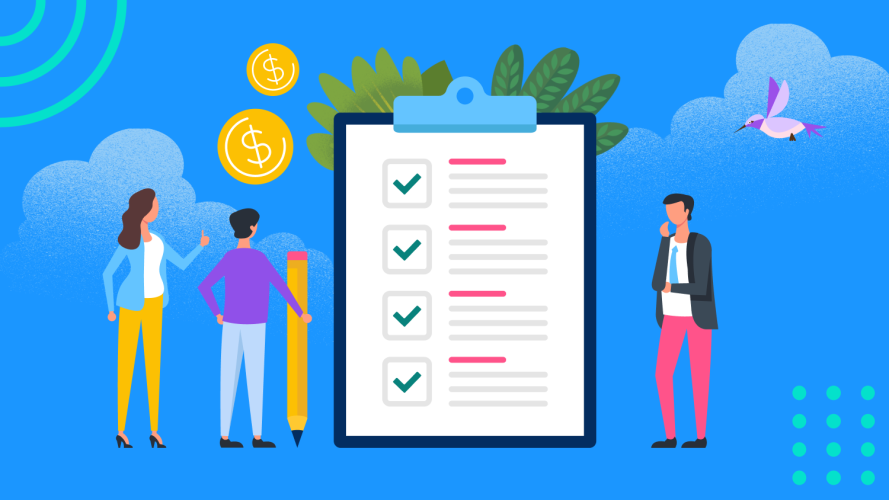
The Sales Team’s Guide to Using Mutual Action Plans
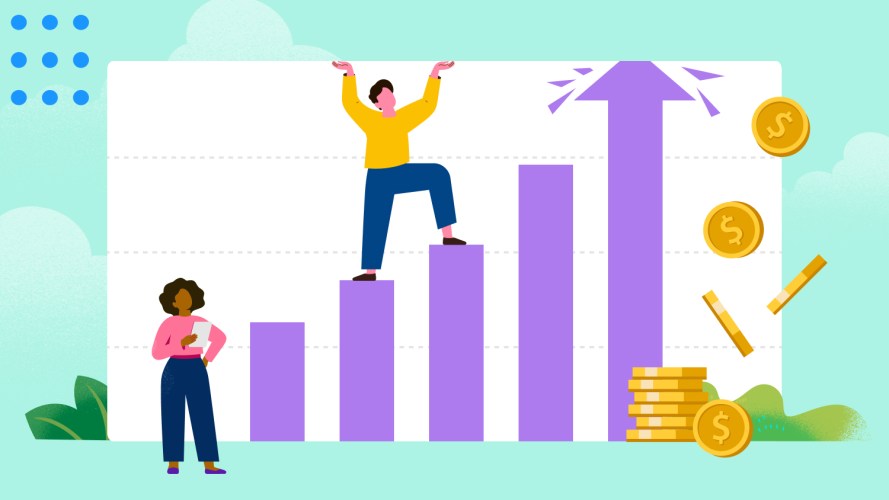
Why Are Commission Caps So Rare in Modern-Day Sales?
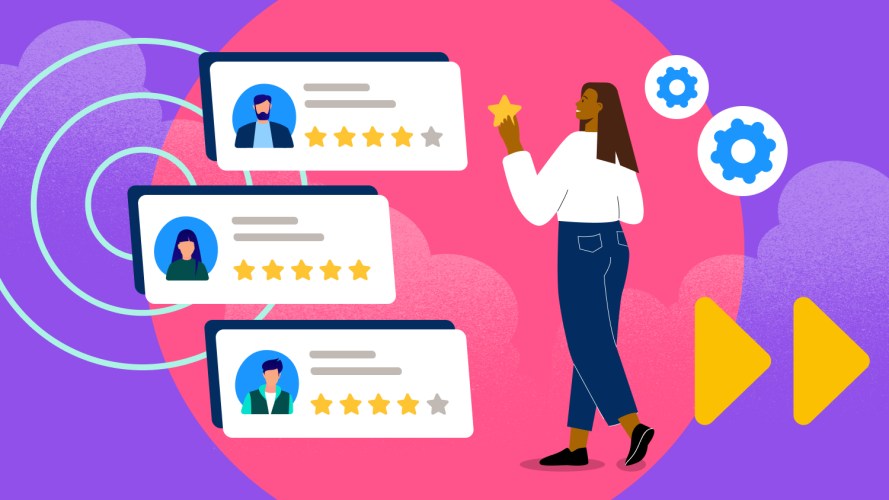
What Is Sales Performance Management? Examples and Tips

New to Salesforce?
- What is Salesforce?
- Best CRM software
- Explore all products
- What is cloud computing
- Customer success
- Product pricing
About Salesforce
- Salesforce.org
- Sustainability
Popular Links
- Salesforce Mobile
- AppExchange
- CRM software
- Salesforce LIVE
- Salesforce for startups
- América Latina (Español)
- Brasil (Português)
- Canada (English)
- Canada (Français)
- United States (English)
Europe, Middle East, and Africa
- España (Español)
- Deutschland (Deutsch)
- France (Français)
- Italia (Italiano)
- Nederland (Nederlands)
- Sverige (Svenska)
- United Kingdom (English)
- All other countries (English)
Asia Pacific
- Australia (English)
- India (English)
- Malaysia (English)
- ประเทศไทย (ไทย)
© Copyright 2024 Salesforce, Inc. All rights reserved. Various trademarks held by their respective owners. Salesforce, Inc. Salesforce Tower, 415 Mission Street, 3rd Floor, San Francisco, CA 94105, United States

A definitive guide to the buyer’s journey
What is a buyer’s journey.
The buyer’s journey is a framework for thinking about the stages that a buyer goes through in the complex purchase typical in B2B. It allows sellers to arrange their tactics to best help their buyers navigate each of those stages and to measure their effectiveness at creating advantage as they do. Summarised as awareness, consideration, and decision, it is often broken down into further stages.
B2B Buyer's journey as a framework for sales and marketing performance
Growing businesses – whether start-up, small, medium or enterprise – want a sales and marketing engine that performs. At what though? Revenue is a measure but a flawed one for both Sales and Marketing; this year’s revenue often contains sales success from past years and delivery success since. Revenue growth (rather than absolute revenue) might be more accurate. But that, too, is a difficult measure. Is revenue growth this year a function of price increases, amazing delivery of value from the operational side of your business, usage growth by your customers, or the efforts of Sales and Marketing?
Closed sales this year/quarter/month is a better measure for sales and marketing as it strips out these impurities. Your decisions about whether you record the value of closed sales by number, number of new logos, annual contract value, anticipated lifetime value, and revenue or gross margin is situational.
Regardless, closed sales is a lag indicator. Before a sale, we have preference. And before that, we have an offer of some sort. Before an offer, we have a scoped need, and other stages like basic awareness still earlier.
We (Sales and Marketing) want to choose the right tactics, and we want them to work.
It turns out we also want our strategy to work. We consider strategic questions like:
- who do we want to be exposed to those tactics?
- and what are we going to sell them when they are?
- and who’s going to execute the tactic? Is it for us or our resellers?
As I’ll argue in this essay, the buyer’s journey is a framework for optimising both your tactics and your strategy, and therefore your performance.
Why the B2B journey is really different
Marketers who are more familiar with consumer marketing than business to business marketing will tell us, “Businesses don’t buy, people do”. While true, this is a sure sign of someone who’s not had a lot of experience marketing to businesses.
In consumer marketing (B2C), you can make an amazing and provocative piece of creative, make people laugh, slap the logo on the end, and you’re done. I’m kidding of course, but only just. Consider some of the funniest ads you saw last night and try to remember the brands.
Most B2B buying is especially complex. Business (B2B) marketers understand that their buyers take many steps on their path to purchase, and they often take many weeks, months or years to make a decision. And there are many players involved on both sides.

And in B2B, we need to use many, many tactics to help buyers move through this complex and time-consuming journey. So, the job of any tactic isn’t to sell but to move.
From where?
And what went on before this particular tactic that might influence a buyer’s receptivity to this tactic? To bring in the father of persuasion Robert Cialdini, how were they persuaded (sic)?
That is, what ‘priors’ do they bring to each stage in the journey? In a perfect world, we might have been the author of all of those ‘priors’. In reality, this is rare.
Buyers take a journey
The buyer’s journey is a progression of thought. It might help if I describe it backwards first to unpack the buyers journey stages, then forwards so you can think about how you might optimise that journey.
- Why do I need something like xx anyway, though?
- And what will happen if I don’t buy something like xx?
- Who might I consider?
Let’s now play that forwards using slightly different language:
- I know you (but don’t really care)
- I’m curious enough (but still not terribly motivated), perhaps look at solutions and concepts for a while without really knowing what I ought to be looking for
- I bounce in and out of those moments for eons until…
- I have a problem worth fixing
- I explore options, talk to vendors, colleagues, friends, advisors, scratch my head and arrive at a view about what I need (from someone)
- Maybe I retreat and return a few times before landing on a clear enough idea about what I need
- Then I get more proper offers from one or more options. That can be anything from a super formal tender to a phone quote or DIY web-config, but now I know what the deal is
- Then I discard options until one seems to be the best path
- And if I work at a big company or am an otherwise clear target, maybe before that whole journey started, someone had my name in a database, and I didn’t even know that I was a ‘target’.
Buyer's journey stages (high level first)
Some writers like to argue that the buyer’s journey is not linear and might use language like “the funnel is dead”. Cute, but not terribly helpful. It is perhaps more helpful to think of the journey as iterative than linear.
Many have had a go at defining and articulating the buyer’s journey. I like HubSpot’s attempt. https://blog.hubspot.com/sales/what-is-the-buyers-journey
They distil the multiple stages into three:
- Awareness stage
- Consideration stage
- Decision stage
A nd they acknowledge the changing awareness for the buyer at each stage:
- Awareness – pain/problem aware
- Consideration – solution aware
- Decision – provider aware
Sourced from HubSpot
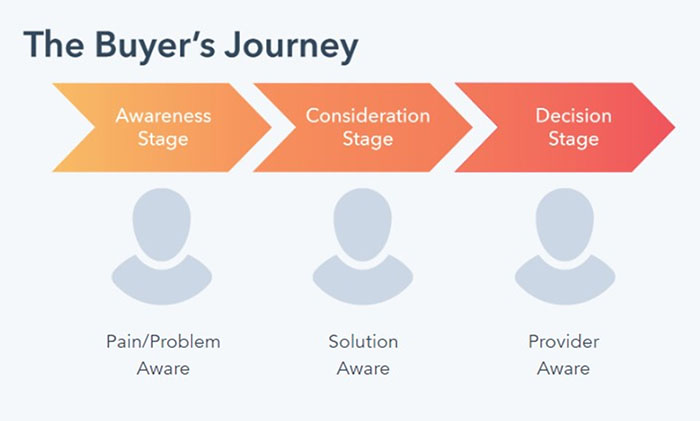
At align.me, we use a more-granular journey for a few reasons, which I’ll argue here. But I’m still comfortable with HubSpot’s somewhat-simple top/middle/bottom of funnel stratification.
Even at this very high level, though, I’d use different language (just to be picky). Buyers are usually aware of the provider(s) early in the journey, not just late.
The B2B buyer's journey has many stages
Sales and Marketing both have roles in helping buyers to navigate their journey. Pre-sales does too. Is it the case that Marketing owns the awareness stage, Pre-sales the consideration stage, and Sales owns the decision stage?

Let’s flip to the buyer’s view of this journey. For a buyer, gaining clarity about what they need – whether from you or someone else – is a key stage in their journey. Once they’re clear about what they need, they can view and judge solutions well.
But why do they need a solution at all? What is going on – or what risks going on – that gives rise to this need? Put differently, what problem are they trying to solve? And what would the consequence be for not solving that problem? These are key questions for a buyer.
Whatever good things the business is trying to achieve (growth, cost reduction, expansion, compliance, etc.), those goals and objectives face hurdles. Maybe the business lacks know-how, resources, or capabilities. Maybe they lack something less human, like data or systems.
In pursuit of their objectives, a business will face:
- Impediments
- Constraints
For a seller, it doesn’t make sense to offer a solution until there’s agreed clarity about the need. And the need is informed or triggered by this gap.
The difference between this gap and the need is key. It’s also the seller’s best opportunity to create positive influence. One seller might be superior at meeting one articulation of the need, and another seller better at meeting a different articulation of the need.
Let me give you an example. A part of our own business is go-to-market planning . If you believe that you need a go-to-market plan that is largely similar to others’ and you don’t have many stakeholders, then we’d be competing with low-priced books, courses, eBooks and the like.
But if you believe you need a go-to-market plan that is unique and has been built and bought into by a dozen senior contributors, then our workshop-driven approach would be more attractive.
Let’s push that further. If you believe that you need a go-to-market plan that is informed by deep research, sector analysis, contributions from hundreds of customers and your field, then align.me would be competing with Bain, BCG and McKinsey.
We do sometimes. But we win when the need is for a go-to-market plan built and bought into by your senior contributors. So as a seller, if we’re granted an opportunity to shape your concept of the problem you want solved and what you need to do so, we’ll argue the need for team input and suggest that you need a plan built in a few weeks, not in many months. And we’d argue that you need a plan built within a sane commercial cost range and so ought to be leveraging some sort of clever tech to allow us to do so.
I won’t take that argument any further lest you think I’m trying to shape your thinking :).
When the buyer begins their own journey, you need to be visible
If it doesn’t make sense to offer a solution until there’s agreed clarity about the need and the gap, is that true earlier? That is, should we be trying to trouble a potential buyer when we are just getting onto their radar?
Sometimes you do. Perhaps you want to be positioned in their mind as one of the credible providers of a solution in a certain category. But you might also want to be positioned as someone who can solve a certain type of problem.
If a B2B buyer is already looking for solutions in a certain category, they might be Googling that category, researching listing sites like Captera, or consulting with analysts like Gartner. In this case, we should position as a credible solution and use good questioning and discovery techniques to take them backwards in the journey to reshape their concept of what they need. Done well and authentically, a buyer can believe they need A/B/C when they start and legitimately and wisely conclude at the end of that process that they need B/C/D.
For a buyer not yet looking, we might position as someone who has insights into their problems and can help.
The job of tactics is help buyers to progress through each stage of the journey
Pick any common tactic in B2B sales and marketing and think about the stage in the buyers journey where this best fits. Or most often fits.
Consider case studies for example. They are a common and effective way for a seller to evidence their ability to deliver value. A case study can describe the entire journey that the buyer took and continue on to describe the outcomes achieved.
But we can also optimise any case study for one or another buyer’s journey stage. Consider how you might optimise a case study in these common use cases:
- A buyer who can’t (yet) see some of the barriers they will face as they pursue their objectives;
- One who isn’t yet clear, or perhaps wrong in their thinking, and what is needed to overcome those barriers;
- One who doesn’t really understand you’re approach to the proposed solution; or
- One who doesn’t understand why this approach will yield better outcomes.
The case study document itself might be optimised for any one of those stages. In theory, we might even entertain the idea of a single case study being manifested as many documents, each optimised for one stage in the journey. This could allow for the automated marketing or the manual selling to leverage the right story to help any individual buyer to their next stage.
An effective case study, though, is rarely optimised for every buyers journey stage.
That little example, and insight from it, suggests that every single tactic needs this simple piece of clarity:
- What do we believe buyers who receive this tactic already think?
- What do we want them to think once we’re done with this tactic?
That’s it. Simple, but a little too rare. Consider any big tactic:
- Executive roundtable
- Seminar presentation
- Discovery workshop
…or any smaller tactic
- Follow up email
- Confirmation call
The job of each tactic is to help a buyer from one thought to another.
Sometimes, they need to be repeated. Consider a nurture series where you might rely on many emails read over an extended period to slowly unlock the grip on one idea to allow consideration of another.

Sometimes they work in tandem with others to successfully achieve a progression:
- An email invitation to a webinar hints at the problem (gap/challenge/barrier/impediment)
- The webinar explores it
- The follow-up email reinforces it
- The 1-1 meetings and discovery sessions personalise and enumerate it
The job of each tactic – alone or in tandem – is to help a buyer from one thought to another along the buyer’s journey.
We get great insights from measuring the buyer's journey
Ask any sales professional about their closure rate – the percentage of their proposals that they successfully close – and they’ll almost certainly know. 25% to 33% (one in four or one in three) is common. Ask them how long their sales cycle is, and they’ll also often have a decent handle on this. Three months is not uncommon, although many in B2B deal with sales cycles that are considerably longer and some are blissfully shorter.
Ask them to break both closure and cycle length down to the stages, and they’ll rarely know.
But they need to.
We’ve built hundreds of go-to-market plans in workshops in 32 countries and thousands using our planning software. And the difference between the shape of average deals that are ultimately won and those that are ultimately lost is telling. This pattern is different for every business, but there are two common patterns:
- If a buyer has been ‘stuck’ at any particular buyer’s journey stage for longer than is normal for you, then the probability of them ever progressing is already low and is getting lower by the day
- If a buyer whistles through a stage faster than is normal for you, double-check that they really are locked in at the next stage. There is a huge risk they will slip backwards later.

Neither do salespeople generally like conceding defeat. Many of the deals that look like they are ‘stuck’ in your funnel have leaked from it long ago.
All that to say, we need to get good at updating progressions so we can gain useful insights into win and loss patterns generally and the probability of each deal specifically.
I coined the term - the Buyer's Journey
In 2003 I wrote The Leaky Funnel. My first version was a prescriptive argument about how to build a go-to-market plan, but I discarded that in favour of writing it as a novel.

In the book, I needed to argue the ideas contained in this essay and to refer frequently back to that idea. I needed a handful of words to collect this idea so that if I had to refer to it 50 times in the book, I’d need a few thousand words only once, and a few words every other time. Like the way we use an acronym like ‘B2B’ as shorthand for business-to-business.
It was for this reason, and not for any grand plan, that I coined the term ‘the buyer’s journey’. It is now a common expression and owned by the universe. But the fire started here. I risk saying this and appearing immodest to argue only a few points:
- I have been thinking about this idea for a long time
- I have a lot of experience using this idea
- Anyone who lays claim to owning the term might want to check around a little
I coined the buyer’s journey as a term, but I don’t own it. No-one does.
Buyer's journey stages
I’ve mentioned a few times that we run workshops to help businesses build go-to-market plans and have software to make that process hyper-efficient.
When I ran the very first Funnel Camp workshop in 2000 for IBM, one of our workshops was to define their own concept of the buyer’s journey. We repeated that for around 20 workshops with other clients and abandoned the journey-definition exercise thereafter as the conclusions were always identical. Each discussion might have started uniquely, but once we analysed, discussed, debated, we always landed at the same articulation of the buyer’s journey. We’ve now run around 500 workshops and used the buyer’s journey to shape every single one.
Since 2020 these workshops have all been done on Zoom. Before 2020, they were all face to face. When COVID-19 pandemic sent the whole world home in March 2020, we made a deliberate decision that our pivot (everyone had one) would be to lean into remote delivery. We modified our Funnel Plan software to enable multiple remote participants to input, rate, and debate options and to decide and articulate their conclusions. We even integrated Zoom into Funnel Plan so that we can kick off a Zoom meeting from inside the software.
All that to say, I am confident arguing that the following is the clearest and most road-test articulation of the buyer’s journey for complex B2B.
Journey stages expanded
You can see parallels to HubSpot’s simpler articulation:
- Positioned in Category
- Interest Established
- Gap Acknowledged
- Need Agreed
- Offer Understood
- Preference Formed
- Decision Made
But we’ve added two stages in the buyer’s journey that don’t fit neatly into HubSpot’s model. HubSpot are famous for championing inbound marketing. And why not? But many of us in B2B have to do lots of outbounding too. And for this reason, we need to begin with a stage that’s not truly a buyer’s journey stage, but when choosing tactics (coming up next in this essay), there are many key tactics needed to find the right names.
And the same is true of the recycling that we need to do to those buyers who have leaked from the funnel and need to be nurtured back in.
Typical tactics for each stage in the buyer's journey
Every business needs to craft its own set of tactics. And they should have the CEO (or divisional head) and the heads of each of Sales, Marketing, Pre-sales in the room when they craft their tactics for the buyer’s journey, and often a half a dozen others who report to these leaders. And they probably should have an experienced facilitator lead them through the process of considering, debating, forming their tactics roadmap for the buyer’s journey
The result might look something like this:

And for buyers who leaked from the funnel and needed to be nurtured before returning to the funnel, we might expect tactics like:
- Email blog to those we have email addresses for
- Google remarketing for website visitors
- LinkedIn remarketing for the subset of our website visitors who also meet our ideal client profile as defined in our LinkedIn filters
In our Funnel Plan we’d represent this as a series of inter-connected tactics:

Buyer's journey implementation plan
Enough with the theory. Here are some steps for your to consider:
- Rename the stages in your CRM to be those of the buyer’s journey, rather than the sellers. It doesn’t matter where you are. It matters a lot where they are.
- Set gates up for your marketers and salespeople to define what indicators you’d expect to see from the buyer to suggest they have completed this stage in their thinking, and what actions your sales and marketing folks need to take to close out this stage.
- Get your sales and marketing leadership together to build a buyer-centric strategy (not “what do we sell and to whom?” but “what problem to we solve, and for whom?”. Remember your team should include CEO (or divisional head), and the heads of each of Sales, Marketing, Pre-sales and a half a dozen of their reports.
- Have that same team identify the tactics you’ll use to help buyers to navigate each stage of the buyer’s journey
- Build reports in your CRM to track lag (time) and leakage (failure to progress) for each stage in your buyer’s journey, and use those measures to inform changes to your strategy and your tactics.
…oh, and if you need a little help from someone who’s led this initiative before, do let us know.
Share This Story, Choose Your Platform!
About the author: hugh macfarlane.

The complete guide to the buyer’s journey

With ever-evolving consumer behaviors, multiple touchpoints, and an abundance of information available, it’s crucial for businesses to unravel this complexity and gain clarity on the buyer’s journey. However, understanding the path your customers take when choosing to make a purchase can be complex and confusing.
In our guide, we’ll explain the stages of the buyer’s journey, as well as how you can use it to inform your sales strategy.
This post will explain:
- What the buyer’s journey is
The importance of the buyer’s journey
The stages of the buyer’s journey, buyer’s journey vs. customer journey, using the buyer’s journey to influence your strategy, what is the buyer’s journey.
The buyer’s journey encompasses the path a customer takes, starting from the recognition of a problem or need, followed by the evaluation process, all the way to the acquisition of a suitable solution.
By proactively addressing the needs and expectations of customers at each stage, companies can create a seamless path that leads to higher customer satisfaction, stronger relationships, and increased sales.
Ultimately, the buyer’s journey is similar to a sales funnel, but instead, it shows the journey from the customer’s perspective. It also details how each step leads to the next, ensuring customers don’t drop out of gaps in the funnel.
Now that you know what the buyer’s journey is, we’ll explore some of the various reasons why understanding it is important for business success. The buyer’s journey:
- Facilitates the identification of challenges encountered by your target audience throughout the purchasing process
- Enables the examination of the choices customers make at each stage, offering valuable insights into their decision-making patterns
- Encourages a solution-oriented approach in your marketing efforts, ensuring that your messaging aligns with customer needs and pain points
- Enables the customization of marketing strategies to specific audiences, leading to more targeted and effective campaigns
- Builds trust with your customers by demonstrating a deep understanding of their journey, fostering credibility and loyalty
- Enhances the customer experience by addressing pain points, providing relevant information, and delivering personalized interactions
- Enables data-driven decision-making to help business leaders make informed decisions, refine their marketing strategies, and allocate resources effectively to maximize their results
After learning about the importance of the buyer’s journey for businesses and marketers, we will break down the buyer’s journey and explain its three different stages.
1. Awareness
During the awareness stage, customers recognize that they are facing a problem or a need, but they haven’t identified the specific solution yet. This realization can occur through independent research or by encountering marketing content that highlights the existence of the problem.
In addition, at this point, customers may not be aware of a business’s products or services and are primarily focused on understanding and defining their needs.
2. Consideration
In the consideration stage, customers have progressed beyond mere awareness and are now actively exploring multiple solutions available to address their identified problems and needs.
Customers are evaluating different options and assessing which ones align best with their requirements and preferences. During this stage, it’s crucial for businesses to provide comprehensive information, comparative analyses, and compelling value propositions to position their products or services as appealing options.
3. Decision
At the decision stage, customers have made a firm decision on which specific product or service they will choose to solve their problem. However, they have not yet made the actual purchase.
This stage involves finalizing details such as pricing, terms, and any additional considerations before committing to the chosen solution. This is the stage where it’s essential to provide your customers with clear and persuasive calls to action, as well as reassure them of their decision.
After learning about the stages, you may be wondering whether the terms buyer’s journey and customer journey are the same. Although these two have some similarities, we will go over some of their key differences.
Scope and focus
The buyer’s journey primarily focuses on the path a customer takes from the initial stage of identifying a problem or need, through the evaluation of solutions, to the final purchase decision. It centers on the pre-purchase stages of the customer’s experience.
In contrast, the customer journey encompasses the entire end-to-end experience a customer has with a brand, including the post-purchase phase. It extends beyond the purchase itself and covers the ongoing interactions, support, and satisfaction that customers experience throughout their relationship with the brand.
The buyer’s journey typically encompasses a shorter timeframe, concentrating on the stages leading up to the purchase decision. It also focuses on understanding the customer’s mindset, motivations, and decision-making process during this specific period.
On the other hand, the customer journey is a broader and more long-term view that considers the entire lifecycle of the customer’s engagement with the brand. It takes into account their experiences before, during, and after the purchase. This includes aspects such as onboarding, customer service interactions, product usage, and potential repurchase or loyalty.
Complementary nature
While the buyer’s journey and the customer’s journey have distinct scopes and timeframes, they are interconnected and can complement each other within a successful customer engagement strategy.
When you understand the buyer’s journey, you can provide valuable insights into how customers make purchasing decisions. This allows businesses to optimize their marketing and sales efforts to drive conversions.
Now that you have an understanding of the overall buyer’s journey, let’s explore ways you can use the information to inform the sales strategy.
- Assess the effectiveness of your buyer personas to ensure accurate targeting of your audience.
- Develop a clear outline of your desired buyer’s journey, specifying the progression from one stage to the next.
- Ensure alignment between your content strategy and sales approach for a cohesive and coordinated customer experience.
- Tailor your messaging and content to align with each stage and effectively guide customers and nurture their decision-making process.
- Optimize the sales process, ensuring a seamless transition from one stage to the next.
Going further with your buyer’s journey
Understanding the buyer’s journey gives you better insight into the process your customers go through when deciding to make a purchase.
When you’re ready to get started, start to outline what your current buyer’s journey looks like so you can define when customers move from stage to stage and begin to identify areas of optimization.
Adobe Marketo Engage allows you to map the buyer’s journey and gives you the data you need to measure engagement at every stage and identify areas of low conversion.
To find out how Marketo Engage can help you optimize the buyer’s journey, watch an overview or take a product tour .
https://business.adobe.com/blog/basics/customer-journey
https://business.adobe.com/blog/how-to/unleashing-experiences-conquering-the-art-of-journey-optimization
https://business.adobe.com/blog/how-to/the-four-stages-of-delivering-customer-journey-maturity

Marketing91
What is Buyer’s Journey? Definition, Stages, and Examples
August 9, 2023 | By Hitesh Bhasin | Filed Under: Marketing
The Buyer’s Journey is a term used to describe the cycle of events that customers go through when they are considering making a purchase. The journey typically begins with a customer recognizing their need for a product or service, then researching various options, and eventually making the decision to purchase.
At each stage of the buyer’s journey, companies must be aware of how their brand is being presented to potential customers. It’s important for businesses to craft a unique and memorable brand voice that speaks to existing customers as well as prospects at different stages of the buyer’s journey.
Table of Contents
What is the Buyer’s Journey?
The Buyer’s Journey can be defined as the process or stages a potential customer goes through from discovering a brand to making the final purchase. It’s a path guided by the brand’s unique voice and identity that resonates with customers at each stage. Buyer’s journey stages are often categorized into three primary types – Awareness , Consideration, and Decision.
An example of the buyer’s journey would be someone who discovers a new brand on social media, researches the product, and then compares prices before making a purchase decision. At each stage, they come into contact with the brand’s message, which should feel consistent no matter what platform it appears on.
It is also sometimes called the purchase journey. In simple words, a buyer’s journey describes what a customer has to go through to purchase a product or a service. If you were to create a buyer’s journey may, it would involve mapping out all the interactions, decisions, and actions that the prospect takes from defining his problem to identifying the solution.
The key to the journey map is to observe how the prospect behaves in each step of the buying process. It is similar to how playtesting happens in gaming. Game developers observe how players are playing, find out their pain points, and develop the game accordingly. Mapping out the buyer’s journey helps the company determine the pain points of buyers. Then can then influence the buying process so that no gaps are causing the buyers to drop out of the sales funnel .
Why is Studying Buyer’s Journey Important for your Sales Strategy?
Studying the Buyer’s journey is important because it allows businesses to understand the customer’s thought processes, behaviors as well as decision-making patterns. This further helps the company decide whether there is a need or a problem that the company is not fulfilling. Thus, this helps the company research the necessary solutions so that their buyers end up making a purchase.
Some of the reasons that the understanding buyer’s journey is important for your sales team are-
1. Focus on Customers: Businesses can lose focus on their customers and match their needs in each stage of the purchase process. This, therefore, makes their marketing more efficient and effective.
2. Product Development : Studying the buyer’s journey helps the business to determine features or elements missing in their current product line. This can lead to better product development. Example: Lego conducts mindstorms where initially they just observed kids playing with toys.
3. Sales Strategies : Companies can realign their sales strategies basis on the buyer’s journey as well as customers’ needs.
4. Customer Experience : Better customer experience during the buying journey helps improve the overall purchase experience, fosters repeat purchases and leads to better word-of-mouth referrals.
5. Competitive Advantage : A company that is studying the journey of its customers will always be able to design superior products and service solutions that will give them a competitive advantage over the competitors.
6. Pull Strategies : Based on what the buyer is looking for, companies can design their pull strategies so that customers themselves approach the company. Example: Apple iPods were designed by observing the pain points of Walkman or CD players.
7. Retaining Customers: Finally, once the company is attuned to observing its customers, they fill all the gaps leaving the customer happy at the end of his buying journey. This results in customer loyalty , and retention and turns customers into brand advocates . Example: Ikea always keeps observing the movement of customers around the store and rearranging its display accordingly.
What are the Three Stages of the Buyer’s Journey?
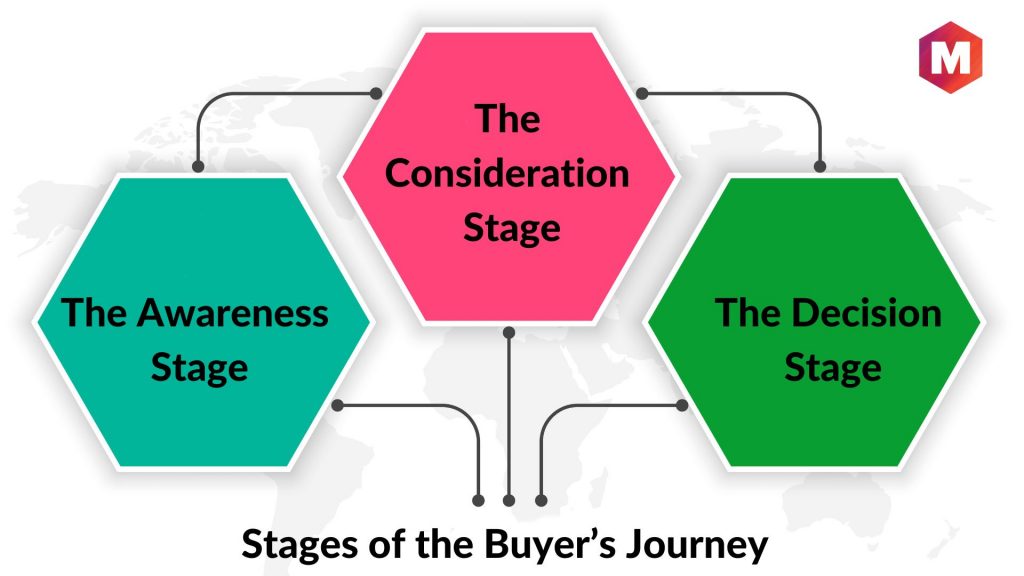
The Buyer’s journey has three stages which are the awareness stage, the consideration stage, and the decision stage. When studying the Buyer’s journey, these three stages evaluate the prospect’s decision-making process.
Each stage in the buyer’s journey may have challenges. It is your job as a marketer to resolve the challenges and ensure a smooth process for the customer. If you are a business owner, it is your responsibility to remove as many obstacles from a buyer’s journey as possible. Let’s now go through the three stages of the buyer’s journey that are crucial for any successful sales process –
1) The Awareness Stage
The buyer’s journey begins at this stage. The awareness stage in the buyer’s journey is when the customer becomes aware that he has a problem or a pain point. They have just started to look out for a solution.
For example, I realize that I have put on some weight and I would need to exercise a bit. However, I do not know where to begin. I do know though that I have to start exercising.
At this stage, I am not clear on what I want to do. I will probably start learning and understanding the different options for exercising. I could go to youtube , buy a book from Amazon or subscribe to a health magazine. There are many solutions available to my problem.
In essence, Once a customer is in the awareness stage, they might have several options in front of them. They are just aware of their problem and they have resolved that they want to solve this problem. That’s the awareness stage. Once the customer is aware, he then moves on to the next step.
2) The Consideration Stage
The consideration stage is when the prospects consider different solutions to their problems. They seek out more information on the problem they are facing and try to find solutions to it.
The information may be found by googling, asking people they know, or social media or even forums. They may get information like quick fixes, suggested products, recommendations from someone personally as well as potential solutions.
Prospects generally weigh their pros and cons in the consideration stage before reaching their buying decision. This is the stage where most companies can persuade customers into buying their products and prospects can be influenced with correct information.
For example: Now that I am aware I need to get fit, I go to YouTube as well as Google , to search for information that I want. This leads me to a content influencer who recommends that I join a Gym or at least get an exercise bike at home. I could also join some sports or start trekking as a hobby. So I am considering a lot of different alternatives. In these, I am also weighing my pros and cons. Example: I like the exercise bike option the most because as I am a writer, any time I have a 15 min break, I could put it into exercising (P.S. This is hypothetical, I am not that disciplined). So now I have considered all my alternatives. This helps me move to the decision stage.
3) The Decision Stage
The decision stage is the final stage of the Buyer’s journey where he chooses a product or a service that will solve his pain points and appears to be the most correct choice for the customer.
This is a stage where the prospect is focused on gaining more information on the decided product and even at this stage, the salesperson has to be vigilant lest the customer may change his mind. Highlighting the strengths of the products and understanding the pain points of the customer is critical to reaching a sales conversion point. Even at this stage, the customer is probably looking for answers to his question regarding the decided product. These questions might be on warranty, maintenance, EMI, paperwork, customer service hierarchy, and any of the other questions a customer might have.
Continuing my example. I have decided that I need an exercise bike. I go to Decathlon and look at all the options available. I am looking for something compact, that can fit easily in the space I have decided and is durable. Basis on this, I find the right exercise bike at Decathlon and checkout with it.
The best part is, in the internet age, a lot of the considerations are driven via the internet itself. This is why, businesses need to have a strong internet presence if they want to win in the buyer’s journey.
Creating Content for Each Stage of the Buyer’s Journey
Content is a crucial part of the buyer’s journey and helps build trust with your potential customers. To ensure you are creating content for each stage, start by identifying your target audience and developing effective buyer personas.
Then, create content that speaks to their needs at every stage in the process, help them make an informed decision, and build brand loyalty . Sales reps have a huge role to play in creating content that resonates with the target audience. They can use customer feedback and develop blog posts, articles, case studies, and other forms of content that address their customers’ questions or problems.
These pieces should be written using the brand voice and tone of your company to ensure a consistent message is delivered each time. Additionally, content should be tailored to meet the needs of each stage in the buyer’s journey. Keep in mind that all pieces should be engaging, and informative, and include calls-to-action (CTAs) when appropriate.
Content Ideas for Each Stage
1. Awareness stage – Create a blog post that provides a comparison between different models, generates buyer personas to identify potential customers, and develops a solution strategy for your sales reps to utilize. You may also create social media posts, whitepaper, how-to videos, checklists, Ebook, educational webinars, etc
2. Consideration stage – Focus on providing relevant product information, highlighting customer reviews and testimonials, offering informative case studies, and developing an FAQ section. Additionally, you can create content such as product comparison guides, free samples, etc.
3. Decision stage – Aim to create content that will entice buyers to make a final purchase decision. Examples include product demos, free trials, discounts/promotions, consultation offers, etc. You should also ensure that your brand’s voice is consistent throughout the buyer’s journey in order to build trust and loyalty with potential customers.
How can the Companies use the Buyer’s Journey for their Benefit?
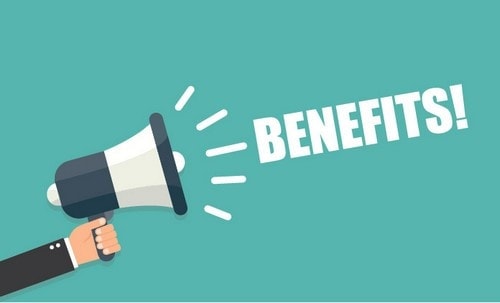
Now that we understand what the buyers’ journey is made of, it becomes essential for the companies to use it in the best possible way to enhance the growth of their own companies. Now for the companies to tackle the buyers’ journey and the best solution to make the best out of it, they should approach it in a stepwise manner.
1) The companies need to define their buying persona
The companies first need to understand the journey that their targeted customers, i.e. their buyers take. And for this, they need to understand their customers, their needs, their demands, their income and how much are they willing to.
2) The companies need to understand the journey that their buyers take
Once the companies can figure out who their potential buyers are, their job becomes to figure out the different processes through which they will approach their customers.
3) Mapping the content to the buyer’s journey
And once the customers are known and their journey is understood, the last and final step for the company is to map the journey in which they will be tracking down every single step of their customers and address the various solutions and challenges they may come across through this journey.
In this way, the buyers’ journey plays an important role for the companies who are selling their products to the marketers. By analyzing the buyer’s journey, one can come up with potential solutions that will help them in overcoming the challenges and increase their sales revenue.
Buyer’s Journey vs. Customer Journey
Customers have a unique path they take when it comes to researching, purchasing, and using products or services. This is known as the buyer’s journey.
But what businesses should also be aware of is that customer journeys encompass every step beyond the purchase too – from initial discovery through ongoing support after the sale has been completed. By understanding and improving each touchpoint along this customer journey, companies can build strong client retention levels which will lead to long-term loyalty and success.
Monitoring both journeys is essential to guarantee that they cohesively integrate. Any customer who purchases your business may observe any disparity between how you cater to potential customers and existing ones, so it is crucial to maintain consistency in the quality of service provided regardless of where a particular individual sits along their buying journey.
Steps of Applying Buyer’s Journey to the Sales Cycle
Having learned the critical aspects of the customer journey, it’s time to look into how you can incorporate them into your sales operations -
1) Evaluate your buyer personas
To completely understand our target audience and customers, we must analyze buyer personas – a thorough account of customer experience that includes Age, Gender, Location, and other pertinent details such as Likes and dislikes, Profession, Education level, Income Level, and Values.
2) Define your buyer’s journey
The moment you pinpoint your target customer, it is time to construct a journey that suits your sales funnel and/or pipeline.
3) Align your content with your sales strategies
Having determined the type of content your buyers require at each stage, you must ensure that your own sales teams and reps are adequately prepared to maximize every opportunity.
4) Perfecting your buyer’s journey
Crafting content that is tailored to the user’s needs and organized for easy comprehension should always be a priority. Additionally, including a strong call-to-action at the end of your writing will encourage customers along their purchasing decision journey.
Buyer’s Journey Examples
1. Awareness stage – Suppose you have an older Smartphone model and are looking to upgrade. Your buyers’ journey could begin with some investigation – examining various models, specifications, costs, etc.
2. Consideration stage – As buyers move further down the Buyers’ Journey, they must decide between their top choices and compare different models. Once they have settled on a specific model, it is essential to ensure that reputable sellers with positive customer reviews are located to make an informed decision.
3. Decision stage – If a Smartphone user completes the Buyer’s Journey, they should be sure to examine all of the details and take time to consider any warranties or services that may accompany their purchase. By doing this, they can make an informed decision that best fits their needs.
How do you track the Buyer’s Journey Stages?
When tracking the stages of the buyer’s journey, it is important to have a good understanding of your target customer and the various touchpoints that contribute to their decision-making process.
Tracking data from customers such as clicks, page visits, lead forms, call times, etc., can help you better understand what channels are most effective and where improvements can be made for increased sales. Customer Relationship Management (CRM) tools are integral components in managing and understanding the Buyer’s Journey.
- Salesforce : Salesforce is a globally recognized CRM tool that offers a comprehensive view of the buyer’s journey. Its advanced analytics capabilities enable sales reps to understand buyer persona behaviors and preferences better.
- HubSpot: Another key player in the CRM tool sector is HubSpot. It provides a seamless interface for tracking customer engagement and behavior, helping sales reps engage effectively with different buyer personas.
- Zoho CRM: Zoho CRM offers a range of features supporting sales rep interactions with customers. It offers deep insights into the buyer persona, helping businesses tailor their communication and marketing strategies .
Conclusion!
Ultimately, the Buyer’s Journey is a crucial element of sales. With this method, marketers can gain an understanding of their prospects’ motivations and desires to create tailored experiences that will move them closer to making a buying decision. By leveraging the power of a Buyers Journey approach, companies have valuable insights into their target audiences and can craft personalized experiences to drive conversions.
Liked this post? Check out the complete series on Marketing
Related posts:
- Buyer Readiness State – Different Stages Of Buyer Readiness
- What is Buyer’s Market? Definition, Examples & Buyer vs Seller’s Markets
- Who is Media Buyer? Role of Media Buyer Explained
- Brand Journey: Definition, Stages and Tips
- Customer Journey Mapping – Overview, Utility and Tools with Examples
- Buyer’s Remorse: Definition, Meaning, Reasons and Prevention
- Buyer Persona – Definition, Importance and Tips
- Buyer Seller Dyads
- What is Product Life Cycle? Definition, Stages & Examples
- Emotional Branding – Definition, Meaning, Stages and Examples
About Hitesh Bhasin
Hitesh Bhasin is the CEO of Marketing91 and has over a decade of experience in the marketing field. He is an accomplished author of thousands of insightful articles, including in-depth analyses of brands and companies. Holding an MBA in Marketing, Hitesh manages several offline ventures, where he applies all the concepts of Marketing that he writes about.
All Knowledge Banks (Hub Pages)
- Marketing Hub
- Management Hub
- Marketing Strategy
- Advertising Hub
- Branding Hub
- Market Research
- Small Business Marketing
- Sales and Selling
- Marketing Careers
- Internet Marketing
- Business Model of Brands
- Marketing Mix of Brands
- Brand Competitors
- Strategy of Brands
- SWOT of Brands
- Customer Management
- Top 10 Lists
Leave a Reply Cancel reply
Your email address will not be published. Required fields are marked *
- About Marketing91
- Marketing91 Team
- Privacy Policy
- Cookie Policy
- Terms of Use
- Editorial Policy
WE WRITE ON
- Digital Marketing
- Human Resources
- Operations Management
- Marketing News
- Marketing mix's
- Competitors
RollWorks Resource Center

- Guides & Industry Reports
- Customer Stories
- Product Snapshots
- Trending Blog Topics
The Buyer's Journey: Unlocking Success, One Stage at a Time
- Share this Article
It’s about the journey, not the destination.
Understanding buyer journey stages empowers marketers to deliver the right message at the right time. Using buyer journey stages as part of a greater marketing strategy is like having a treasure map that guides brands toward measurable success, one stage at a time. Not only will you be able to increase conversions and create exceptional customer experiences through marketing but you’ll also make it possible to boost engagement with enviable specificity.
Without further ado, here’s everything you need to know about what the buyer journey stages are and how to maximize their potential.
Buyer’s Journey 101: Definition, Stages, and More
For a marketer, to say understanding the buyer's journey is important is an understatement.
Here’s why:
The number one reason why marketers need to care about the buyer's journey is that it makes it possible to understand their customers' needs, behaviors, and motivations throughout the entire purchasing process.
By understanding the buyer's journey, marketers can create a more effective inbound marketing strategy that targets potential customers with the right content strategy, at the right time, and in the right format.
This not only increases the likelihood of converting leads into customers but it also helps to build trust and loyalty with existing customers. This is becoming more and more critical. As Salesforce’s 2022 State of the Connected Customer finds, “88% of customers believe trust becomes more important in times of change”.
All of that to say, in today's competitive marketplace, understanding the buyer's journey is crucial. Not only does it help with staying ahead of the competition but it’s also fundamental for achieving long-term business success more than ever before.
So what is the buyer journey, really?
The buyer's journey is the process that a potential customer goes through when they become aware of, consider, and decide to purchase a product or service. Understanding the buyer's journey allows marketers to create more effective content marketing strategies and target their ideal customer .
The main buyer journey stages
The buyer's journey is often described as having three stages: the awareness stage, the consideration stage, and the decision stage. But it really all depends on who you ask.
Some experts have claimed that the buyer's journey actually has four distinct phases. Then there are the thought leaders who say it actually includes six life cycle stages instead.
So what’s really going on here and why can’t we all just agree on a number?
Simply put, the concept of the buyer journey is a jumping-off point for a few different marketing and sales models . The terms stages, phases, and life cycles are often used interchangeably which only adds to the confusion. The model and terms you use to define your own buyer journey stages will be unique to your account-based strategy at the end of the day.
To focus our discussion, we are going to focus on the four universally agreed upon buyer journey stages. You’ll find these exact concepts at the root of every buyer journey model.
Here’s what they are and what you can expect from buyers at each stage plus illustrative examples of each:
Stage 1: Target 🎯
In the Target stage, marketers identify and prioritize target accounts based on various criteria such as company size, industry, and buyer personas.
Here is a general overview of what buyers might do during the target stage including examples of actions a buyer might take:
- Identify their needs. Buyers begin by identifying their specific needs or challenges. They assess their current situation and recognize the gaps or opportunities that need to be addressed.
- Define key goals. Once the needs are identified, buyers establish their goals and objectives. They determine what they want to achieve by addressing those needs and what outcomes they are looking for.
- Research options. Buyers engage in research to explore various options and solutions available in the market. They gather information from different sources such as online searches, industry publications, social media, and recommendations from peers or colleagues.
- Seek out recommendations. Buyers often seek recommendations and advice from their professional network or trusted sources. They may reach out to colleagues, industry experts, or online communities to gather insights and opinions on potential solutions or vendors.
- Evaluate alternatives. During this stage, buyers compare and evaluate different alternatives or providers that can meet their needs. They assess features, benefits, pricing, customer reviews, case studies, and other relevant information to make an informed decision.
- Engage with your content. Buyers consume various types of content during their research process. This includes blog articles, whitepapers, e-books, videos, webinars, product demos, and other resources provided by vendors or industry influencers. They use this content to gather insights, understand capabilities, and assess the suitability of solutions.
- Attending events or webinars you host. Buyers might attend industry events, conferences, or webinars to gain a deeper understanding of the available solutions and engage with subject matter experts. These events provide opportunities to ask questions, interact with vendors, and gain valuable insights.
- Look for proof. Buyers look for proof points and validation of a solution's effectiveness. They may seek case studies, customer testimonials, or success stories to understand how other organizations have benefited from a particular solution.
- Request demos or start trials. As buyers narrow down their options, they may request product demos or trials to gain hands-on experience with the solutions they are considering. This allows them to assess usability, functionality, and fit for their specific needs.
- Engage with sales reps. Towards the end of the target stage, buyers may engage with sales representatives to ask questions, seek clarifications, or negotiate terms. Sales reps provide personalized guidance and address any concerns or doubts the buyers may have.
Stage 2: Engage 👩💻
In the Engage stage, marketers begin interacting with target accounts through various channels, such as email, social media, and display advertising.
A buyer in the engagement stage of the buyer's journey might do one or more of the following:
- Contact sales. Buyers reach out to the sales team of the chosen vendor or provider to initiate direct contact. This can be done through phone calls, emails, contact forms on the website, or scheduling meetings or demos.
- Request additional information. Buyers may request further information about the product or service, such as detailed specifications, pricing, implementation process, customization options, or support services. They seek to gather all the necessary details to make an informed decision.
- Participate in demos. Buyers engage in product demonstrations provided by the vendor. They actively explore the features, functionalities, and user interface of the solution to determine if it meets their requirements and expectations.
- Evaluate proposals. As part of the engagement stage, buyers review and evaluate proposals or quotes provided by the vendor. They carefully assess the pricing, terms and conditions, contractual agreements, and any additional services or packages included.
- Review case studies. Buyers often request references or case studies from the vendor to gain insights into the experiences of existing customers. They seek validation that the vendor can deliver on their promises and meet their specific requirements.
- Consult with stakeholders. During the engagement stage, buyers may involve other stakeholders within their organization to gather additional input and perspectives. This can include decision-makers, department heads, IT professionals, or other relevant parties who will be impacted by the purchase.
- Address concerns or objections. Buyers might raise concerns, objections, or questions regarding the solution or the vendor. They engage with the sales process to address these concerns, clarify doubts, and ensure that all issues are adequately resolved.
- Negotiate terms. In the engagement stage, buyers may engage in negotiations with the vendor to discuss pricing, contract terms, customization options, or other aspects of the purchase. The goal is to reach a mutually beneficial agreement that meets the buyer's needs and fits within their budget.
- Seek proof of value. Buyers may ask for additional evidence or demonstrations of the solution's value. This can include requesting a trial period, conducting pilot projects, or seeking specific metrics or data that demonstrate the solution's impact and return on investment.
- Secure internal approvals. Buyers may need to obtain internal approvals or budgetary sign-off from relevant decision-makers or departments within their organization. This buying process involves presenting the proposed solution, its benefits, and the associated costs to gain buy-in and move forward with the purchase.
Stage 3: Convert 🤝
In the convert stage, marketers focus on converting engaged accounts into customers. They will typically provide leads with personalized and relevant content such as case studies, whitepapers, and product demos. Each piece of content can and should be linked to a specific stage of the buyer’s journey, especially this one.
Here are some examples of what someone might do during this buyer journey stage:
- Make the purchase. The primary action in the convert stage is the buyer completing the purchase transaction. This can involve placing an order, signing a contract, or making a payment to officially become a customer .
- Finalize contractual agreements. If applicable, the buyer may work with the vendor or legal team to finalize and sign contractual agreements, ensuring all terms and conditions are agreed upon and legally binding.
- Arrange payment. Buyers take necessary steps to arrange payment for the product or service. This can include submitting payment information, initiating wire transfers, setting up payment plans, or other payment-related activities as per the vendor's requirements.
- Provide necessary documentation. In certain cases, buyers might be required to provide specific documentation, such as business licenses, tax forms, or other legal paperwork, depending on the nature of the purchase or the vendor's requirements.
- Participate in onboarding or implementation. Depending on the complexity of the product or service, buyers may engage in an onboarding or implementation process. This involves working with the vendor's implementation team to set up and configure the solution, integrate it into existing systems, and ensure a smooth transition.
- Attend training or orientation sessions. Buyers might participate in training or orientation sessions provided by the vendor to familiarize themselves with the product or service, its features, and best practices. This helps ensure that the buyer can effectively utilize and maximize the value of their purchase.
- Provide feedback or reviews. After the purchase, buyers may provide feedback or reviews regarding their experience with the vendor or the purchased product or service. This feedback can be shared directly with the vendor, posted on review platforms, or shared within industry communities to help other potential buyers.
- Consider cross-sell or upsell opportunities. During the convert stage, buyers may be presented with additional cross-sell or upsell opportunities by the vendor. This involves considering and potentially purchasing additional products, services, or upgrades that complement or enhance the original purchase.
- Refer or recommend your product. Satisfied buyers may refer or recommend the vendor or the purchased solution to their colleagues, friends, or professional network. They might provide testimonials, participate in case studies, or share positive experiences to help generate further business for the vendor.
- Engage with customer support. After becoming a customer, buyers may interact with the vendor's customer support or service teams for ongoing assistance, troubleshooting, or to address any questions or concerns that arise post-purchase.
Stage 4: Advocate 📣
Finally, in the Advocate stage, marketers encourage satisfied customers to promote their products or services to others through referrals, reviews, or testimonials.
Some actions a buyer in the advocate stage of the journey might take include:
- Provide testimonials. Advocates may offer to provide testimonials or success stories that highlight their positive experience with the vendor or solution. These testimonials can be used by the vendor in marketing materials, websites, case studies, or social media campaigns to build credibility and attract new customers.
- Write reviews. Advocates might write reviews on platforms such as review websites, social media platforms, or industry-specific forums. These reviews help potential buyers gain insights into the quality, benefits, and performance of the product or service from a customer's perspective.
- Refer friends or colleagues. Advocates often refer the vendor or solution to their friends, colleagues, or professional network who might have similar needs or challenges. They actively recommend the vendor, providing personal endorsements and encouraging others to consider the same solution.
- Participate in case studies. Advocates may volunteer to participate in case studies or customer success stories . They share their experience, the challenges they faced, and how the vendor's solution helped them overcome those challenges. Case studies serve as valuable marketing assets that demonstrate the real-world value and impact of the solution.
- Speak at your events or webinars. Advocates may be invited to speak at industry events, conferences, webinars , or user groups to share their firsthand experience with the vendor's solution. By speaking about their success and the benefits they've gained, they inspire and influence others who are considering similar solutions.
- Provide referrals. Advocates actively refer potential customers to the vendor or facilitate introductions between interested parties and the vendor's sales team. They leverage their network to help connect potential buyers with the vendor, acting as trusted intermediaries.
- Engage in online communities. Advocates actively participate in online communities, forums, or social media groups related to their industry or the specific solution. They share insights, answer questions, and provide advice based on their experience, helping others in the community make informed decisions.
- Provide feedback. Advocates continue to provide feedback to the vendor to help improve the product or service. They share suggestions, feature requests, or insights that can contribute to future enhancements and updates, demonstrating their ongoing commitment to the vendor's success.
- Renew contracts or expand usage. Advocates continue to renew their contracts or subscriptions with the vendor, indicating their ongoing satisfaction and loyalty. They may also explore opportunities to expand their usage of the solution, such as upgrading to a higher-tier plan or adding additional features or modules.
- Celebrate shared success. Advocates celebrate their own success achieved through the vendor's solution. They may share their achievements, milestones, or ROI metrics with the vendor and the wider community, reinforcing the positive impact of the vendor's offering.
As you can see from the examples above, there is some overlap between each of these buyer journey stages. However, each one is distinct and serves its own purpose, which makes it important to target and track them throughout the process.
How to track each stage of the buyer journey
In a nutshell: learn how to track events .
Events are specific actions that a prospect takes during the customer journey. For example, visiting a website, filling out a form, or attending a webinar are all potential events. By tracking and analyzing these events, marketers can gain valuable insights into a prospect's interests and behavior. From there they can adjust their account-based marketing strategies accordingly to better suit the needs of the buyer at that very moment.
Today’s Unique Buyer Journey Challenges (and Solutions)
The days of marketing and sales controlling the buyer's journey are over. At least that’s what the 2022 DemandGen report says.
Buyers now rely on self-service as well as anonymous buying journeys, peer recommendations, and social media insights to make purchasing decisions. When it comes to demand gen, the rise of buying groups and committees (consisting of members from various departments) is highlighted as a crucial component of the modern buyer's journey.
The other key trends in buyer behaviors revealed…
the need to expand of the buyer's journey
an emphasis on meeting buyers' desire for anonymization while providing relevant outreach
strong preferences for peer reviews
the need to strike a balance between self-service and sales outreach
Not sure how to fit all of this into the various buyer journey stages in an effective and scalable way? You’re not alone. Achieving the solutions to these major pain points is one of the reasons why many smart marketers are now exploring account-based marketing.
How B2B Marketers Can Effectively Target Buyer Journey Stages
The traditional funnel model focuses on moving customers through a linear progression from awareness to purchase. However, given what we know about today’s marketplace, this is no longer sufficient. Instead, companies must adopt a more holistic approach that considers the entire customer lifecycle , from awareness to advocacy. Marketers will need to map out the customer lifecycle in order to do this.
Companies can improve overall customer experiences simply through mapping out the customer lifecycle and understanding the needs and pain points of customers at each stage. This single shift can lead to increased customer loyalty, higher retention rates, and ultimately, increased revenue.
The following is a framework you can use to effectively implement ABM strategies and improve ROI for each of your buyer journey stages:
Identify target accounts. This step involves researching and selecting the specific companies that are the best fit for your product or service.
Create account profiles. This step involves building detailed profiles of your target accounts, including information such as company size, industry, key decision-makers, and pain points.
Define the account journey. This step involves mapping out the stages that a target account goes through on its way to becoming a customer. This includes identifying touchpoints and creating content that is tailored to each stage of the journey.
Measuring success. This step involves setting KPIs and metrics to track the success of your ABM efforts, such as engagement rates, conversion rates, and revenue generated.
You can create your own outline using these key points or streamline the process using a DIY account journey template .
Frequently asked questions on buyer journey stages:
Create an exceptional buyer’s journey experience for your target audience.
In today's competitive marketplace, grasping the buyer's journey is crucial for staying ahead and achieving long-term business success. Marketers can adapt their strategies to meet the evolving needs and behaviors of buyers simply by targeting each stage of the buyer’s journey.
At the end of the day, embracing the complexities of the modern buyer while adopting agile and omnipresent account-based marketing strategies will make it possible for organizations to drive meaningful results. And better results mean better experiences for the buyers on that journey. Talk about a win-win!
Previous Article

Unlock the power of B2B channel marketing with this comprehensive blog post covering key components, innova...
Next Article

Master the art of B2B content creation with RollWorks' comprehensive guide to crafting a high-impact conten...
Most Recent Articles

Explore how RollWorks' Audience Syncing for LinkedIn revolutionizes B2B marketing by integrating precise targeting and data-driven strategies.

Discover the winning strategy for B2B marketing success with our insights on combining Account-Based Marketing (ABM) with personalized landing pages to dramatically increase your conversion rates.

Discover how ABM and ABA are revolutionizing trust-building in financial services, with insider strategies for cultivating strong, personal client relationships.

Explore strategies for adapting to Google's shift away from third-party cookies.

Discover how ABM triumphs over traditional marketing tactics, with key statistics that showcase its superior effectiveness in boosting conversions, revenue, and customer loyalty.

Level up your SaaS marketing with our tips on leveraging Account-Based Advertising (ABA) for targeting high-value prospects and to boost conversion rates.

Increase campaign engagement & boost customer sign-ups with one (or more!) of these 6 types of retargeting ads. Learn how to get started here.

Explore the transformative power of Account-Based Marketing (ABM) and Advertising (ABA) for B2B manufacturing.

Discover how to leverage account-based marketing to outsmart competitors, close deals quickly, and secure profitability in a tight market with targeted, data-driven strategies.

Master the art of full-funnel B2B advertising and unlock the potential of data-driven strategies to drive revenue.

Discover how Account-Based Advertising (ABA) revolutionizes retargeting by prioritizing high-quality leads over volume, ensuring your marketing budget targets your most valuable prospects.

RollWorks makes the Top 10 of G2's Top Marketing and Ads Products for 2024!

Discover the five crucial elements that will elevate your B2B advertising strategy, ensuring you stay ahead in the competitive digital marketing landscape.

Explore the top 7 B2B advertising strategies to navigate the increasingly digital buyer journey.

Discover how ABM strategies can revolutionize talent acquisition in the competitive job market, with RollWorks' insights on targeting, personalization, and data-driven recruitment.

Discover how to refine your ABM strategy by aligning sales and marketing, segmenting buyer personas, and leveraging intent data for a targeted & personalized advertising campaign.

New year, new strategies. Take a look at RollWorks' Senior Content Marketing Manger Alysha Parker's top 7 predictions of how B2B marketing will look in 2024.

Explore the strategic advantages of Account-Based Marketing in the B2B, showcasing targeted strategies, improved sales alignment, and success stories with RollWorks.

Discover cutting-edge ABM tactics for 2024, including intent data and AI integration, to elevate your B2B marketing and target high-value accounts with precision and personalization.

Boost your ABM campaign results this holiday season with RollWorks' expert gifting strategies and insights from top industry partners for standout customer engagement.
- Account-Based Marketing
- Account-Based Advertising
- Why RollWorks
- Technology Partners
- Agency Partners
- Guides & Reports
- Help Center
NextRoll is as an equal opportunity employer. We stand alongside organizations that support our Rollers and Community .
- Trust Center
- Terms of Service
- Website Terms of Use
- Privacy Notice
- Infringement Policy
- CCPA Notice at Collection
© 2006- , NextRoll, Inc. All rights reserved. RollWorks is a division of NextRoll. To learn more please visit nextroll.com .
Do Not Sell My Personal Information
- Share this Hub
We're There For You At All Hours!
We're here for you..
- Click to Chat
- Schedule a Meeting

Buyer’s Journey: A Definitive Guide
Aditya Srivastava
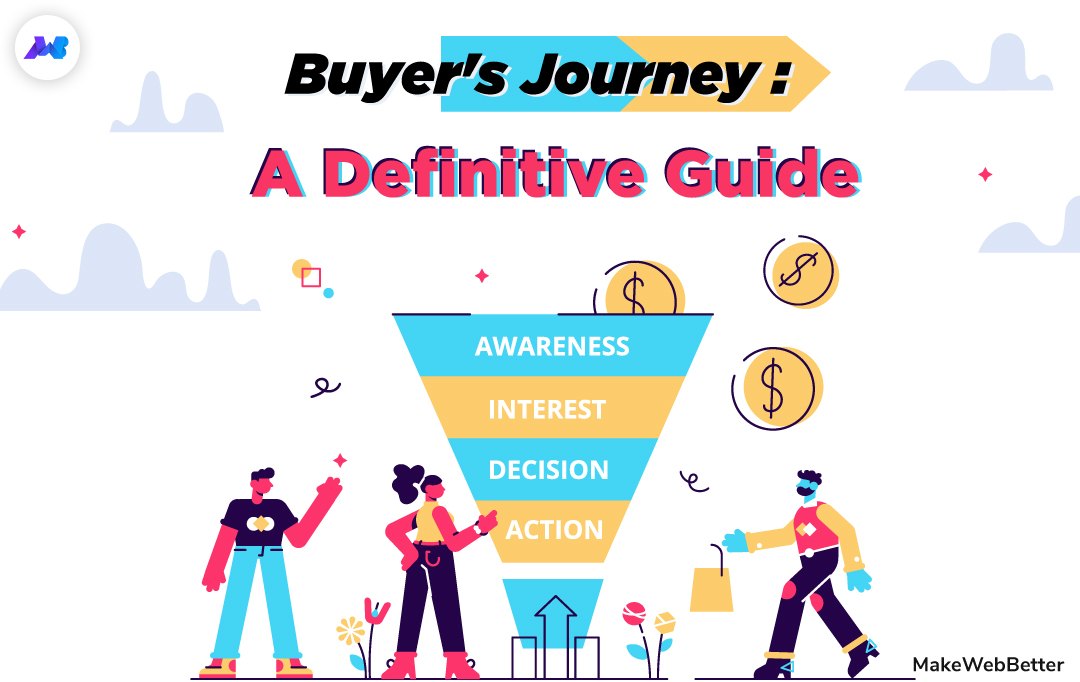
The buyers of today try to learn and understand a product before purchasing it. They are smart and calculative. Buyers want to know ‘if’ and ‘why’ they need your product. Evaluation and research have become an inseparable part of the buying process.
Buyer behavior dictates how customers make buying decisions. And the buying process is a journey, which is taken into account while forming an inbound marketing strategy.
In fact, the framework of marketing strategies is based on the buyer’s journey.
In this article, i have had talked about buyer’s journey and all its aspects. This is a definitive guide of buyers’s journey.
What is the Buyer’s Journey?
Awareness stage nurturing, consideration stage nurturing, decision stage nurturing.
- B2B Buyer’s Journey
- B2C Buyer’s Journey
The Application of Buyer’s Journey
Final thoughts.
Now, the golden question is…
According to HubSpot , the buyer’s journey is the process buyers go through to become aware of, consider, and evaluate, and decide to purchase a new product or service.
This definition tells us that there are three stages of the buyer’s journey:
Consideration
Now, I will describe the buyer’s journey stages in detail and also tell you how to nurture your customer on each stage.
Awareness Stage
In this awareness stage, the buyer realizes or becomes aware of a problem or need. The buyer identifies an opportunity to address the problem, starts his research to find a solution, and decides the primacy of the problem.
This is the beginning of the buyer’s journey.
For example: Sam is looking at the analytics of his eCommerce store and he realizes that bounce rate has increased over the last few months. He recognizes that he has a problem.
Consideration Stage
At this stage, the buyer starts addressing his problem or challenge. Here, the buyer is searching for providers of the desired solution and knows how to reach his goal. This is the middle stage of the buyer’s journey.
For example: Sam later discovers that his website load time has increased which is increasing the bounce rate. He starts searching for ways to decrease the load time of his online store.
Decision Stage
This is the stage where the buyer makes the final purchase decision. The buyer has compared the pros and cons of possible alternatives to the solution (product or service).
And now has solid research and knowledge to reinforce his purchase decision.
For example: Sam finds out that his web hosting service is slow and he opts to an expensive but better web hosting service. In a few weeks, his bound rates decline and traffic increases.
Here are the “leading benefits of understanding customer journeys” according to marketing professionals worldwide as of November 2016.
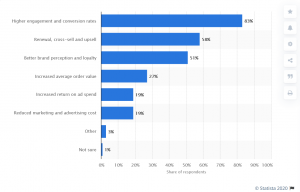
Well, now you know the stages of the buyer’s journey but how do you use this knowledge to help your business?
How do you move customers through the buyer’s journey funnel and convince them to purchase your product or service?
You do that by nurturing your buyer at every stage of the buyer’s journey. It is also known as customer nurturing or lead Nurturing.
What is Customer Nurturing?
Lead nurturing is the process of building a positive relationship with your buyers and reinforcing that relationship by providing value. And here is how nurturing is done:
Buyers do realize their problems or challenges by themselves. But you can also identify problems or challenges for them and give realistic goals to pursue by creating insightful content.
Create content that highlights a problem, challenge, or need and provides solutions for the same. The primary objective is to give valuable knowledge to your customer.
To nurture your buyer, you can use the following types of content:
- Articles and Blog Posts
- White-Papers
- Infographics
- Social Media Posts
In the awareness stage, you have to utilize the power of content marketing to attract buyers. 72% of marketers say content marketing increases engagement.
Proper use of content helps the buyer to identify their goals and challenges. Also, your originally created content makes the buyer notice your brand or business.
At the consideration stage, buyers have defined their targets and problems with clarity. And are actively looking for a solution. So, this is where you provide a solution and show them how you can solve their problem.
Content at this stage should be focused on providing solutions but in such a way that displays your ability to help the buyer.
The content should be insightful and suggestive.
Types of content to use at the consideration stage:
- Customers Testimonials
- Product Trails
- E-seminars or Webinars
- Product Guides
The primary role of created content at this stage is to build trust by providing valuable solutions to the buyer.
In fact, 96% of the most successful content marketers say that content marketing has helped them build credibility and trust with their audience.
This is the final stage of the buyer’s journey and the buyers have got it all figured out. The buyers have defined their problem, they have understood solutions provided by you, and have also looked at the alternatives.
It’s time to make the purchase decision.
You have to assure the buyer that you are the best in the business. Also, make the purchase process easy and attractive.
The role of ‘user-generated content’ is huge at this stage.
In the decision stage, it all comes down to these following factors:
- A reasonable price of your product or service
- An attractive offer on the purchase
- Suitable discount
- Available methods of payment
- Reviews and ratings that reinforce the trustworthiness of your brand
- Satisfied customer testimonials
Let me explain these factors in detail:
Price and Offers
In this highly competitive market , keeping a reasonable price, and giving a discount is important. Giving a limited-time offer also helps close the deal sometimes because it creates a sense of urgency in the buyer’s mind.
Credibility
Reviews, ratings, and testimonials are crucial nowadays because those are the first things buyers look for when they are evaluating you.
In fact, 90% of consumers read online reviews before visiting a business.So, utilize user-generated content as social proof and increase your credibility.
For reference, you can check out how we showcase our reviews and ratings at MakeWebBetter.
Ease-Of-Payment
Availability of different payment options is often undermined but it is a determining factor. You need to allow payments from payment apps, internet banking, credit and debit cards, and other popular payment systems.
Basically, you gotta make it easy for buyers to purchase your product.
Up until now, I have only introduced you to the general definition of the buyer’s journey and the content that goes along with it.
Now, I will go deeper into the subject and talk about the B2B and B2C buyer’s journey.
B2B Buyer’s Journey
Business-to-business buyer’s journey consists of the three general stages; that is, awareness, consideration, and decision but the approach is different because businesses buy collectively and there is always a group of individuals making multiple purchase decisions.
Within a business, the presence of a buying group elongates and complicates the buying process and leads to the addition of more stages in the buyer’s journey.
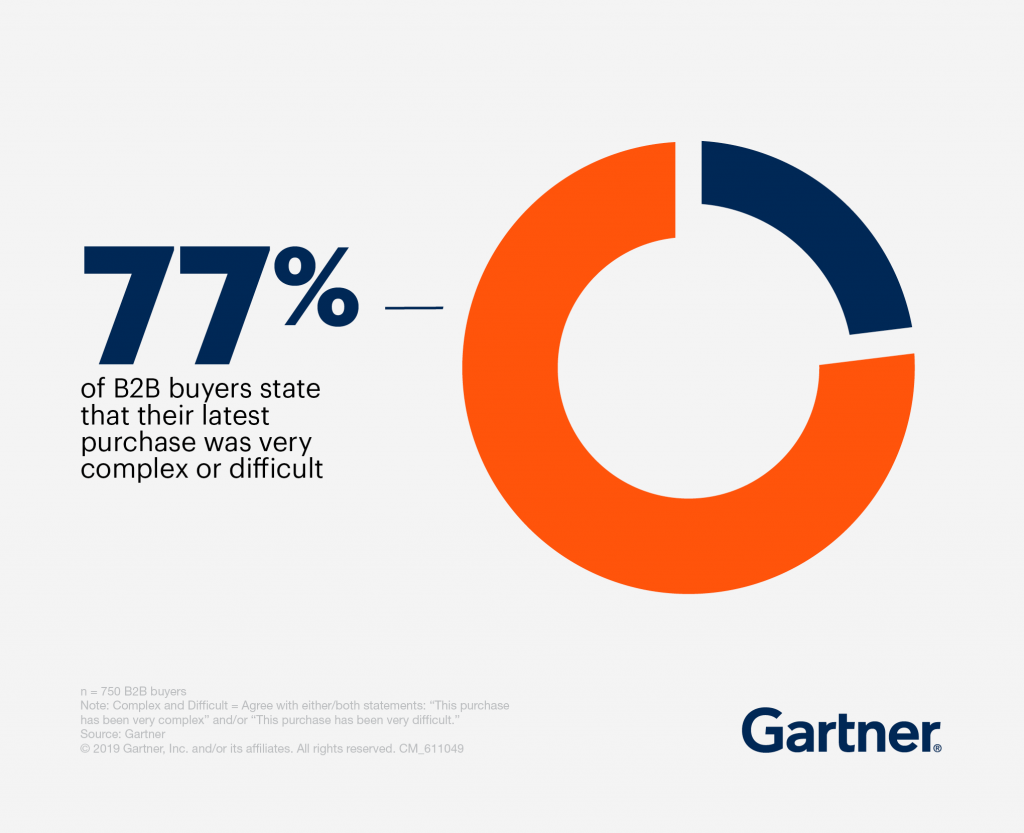
Let’s look at the B2B buyer’s journey stages:
Awareness: This is the stage where businesses identify a problem or a need.
Research: The buying groups start searching for all possible solutions.
Evaluation: The solutions are segmented on the basis of their affordability and applicability.
Selection: The best supplier of the solution is selected at this stage.
Purchase: Lastly, the budget allocated for that particular product or service is utilized in the final purchase decision.
This seems easy on paper but it’s not. Firstly, there is always a need for consensus on every stage of the B2B buying process because a group of buyers is involved.
Everybody needs to be on board.
Secondly, the buying process isn’t straightforward in B2B. And lastly, It lacks linearity because there is a lot of reconsideration and many stages are revisited by buying groups.
In a survey , 77% of B2B buyers agreed that they conduct a more detailed ROI analysis before making a purchase decision.
Businesses don’t make hefty purchase decisions.
Role of Content in B2B Buyer’s Journey
The role of content in a business-to-business buyer’s journey is the same but some types of content are more appreciated by the B2B buyers. Such as:
- Business Reports
- Products Comparison
- Demo Videos
- Supplier Comparison
All of these content types help the buying groups conduct an in-depth analysis of the business they are going to purchase from.
The aim of the content creators here is to provide information that makes it easier for B2B buyers to advance their buying process.
Simplification of the Buying Process
The B2B purchase process is complex and the toughest part is purchasing the product. So, increase the ease of purchase to advance your buyers through the buyer’s journey funnel.
This study shows “the most effective content types in demand generation” during various stages of the buyer’s journey according to B2B marketers in North America as of July 2018.
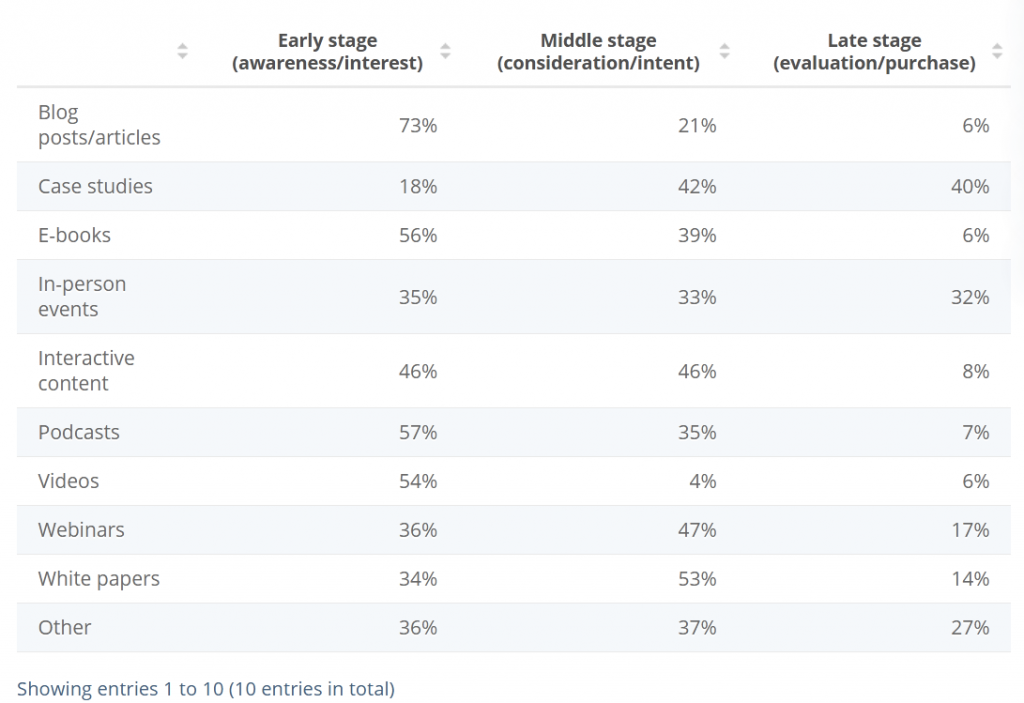
B2C Buyer’s Journey
The business-to-customer buyer’s journey is linear and simplistic, which makes it easy for sellers to map out.
Here are the stages of a business-to-customer buyer’s journey :
The buyers perceive their problems, challenges, and needs. To engage buyers at this stage, these content forms are needed:
Types of Content Used at Awarness Stage
- Informative Articles
- Social Media Advertisements
- Search Engine Advertisements
For example- Adam started weight training at the local gym. He read articles at bodybuilding.com to increase his knowledge of weight lighting. He became aware that he needed quality Whey protein to gain size while weightlifting.
This is the onset of a relationship between the buyer and the seller. The buyer has recognized his problems and is now searching for a solution. As a seller, you can provide the buyers with helpful content to solve their problems.
Present valuable information to awaken the interests of your buyers.
Types of Content Used at Consideration Stage
- Case Studies
- Product Demostrations
- How-to Blogs and Explainer Articles
For example- Adam read many articles on bodybuilding.com related to protein use and its benefits. He started looking for more affordable whey protein supplements.
Here, the buyer has acquired all the information he needs in order to make the purchase decision. At this stage, buyers start evaluating various suppliers that are offering the needed solution.
This research shows people trust recommendations, user reviews, and ratings to complete the purchase process.
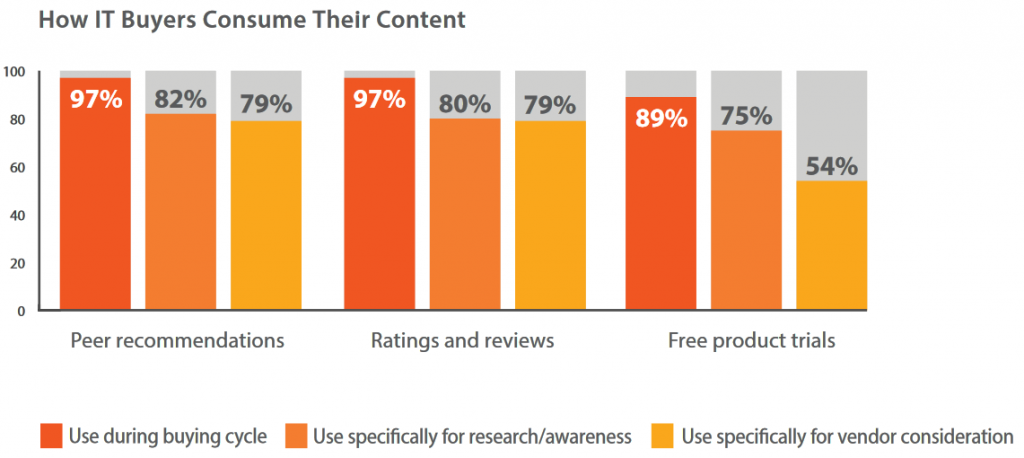
Types of Content Used at Decision Stage
- Customer Reviews and Ratings
- Comparisons with Other Suppliers
- Buyer Testimonials
For example- At bodybuilding.com, Adam read articles, watched customer testimonials, read reviews and ratings. He also found a product comparison at bodybuilding.com which eradicated the last bit of his hesitation and he ordered Whey protein from their store.
Retention Stage
The buyer purchased a suitable product from you and has established a relationship by becoming a paying customer. Therefore, trust has already been established. Now, its all about maintaining that trust.
When a customer is rewarded after making a purchase, he or she is likely to purchase again from you because you positively reinforced his or her buying decision.
So, this is where you turn your newly formed customers into loyal customers that return to your store for more products.
Becuase, acquiring new customers can cost five times more than satisfying and retaining current customers.
Tpyes of Content Used at Retention Stage
- Offer Rewards On Purchase
- Personalized Follow-up Emails
- Relevant Product Recommendations
- Relevant Offers
In summary, offering value to customers along with your product should be your primary objective.
Like a ‘Thank you’ email to customers right after the purchase would give a personalized experience.
For example: Right after Adam made the purchase, he received an onboarding email from bodybuilding.com and also started receiving emails of best offers. He also received a 5% discount on his second product purchase.
Promotional Stage
At this stage, you have earned the loyalty of your buyers and provided them the quality product or service they were looking for. The buyers will keep using your service or products and return to you for more.
Make sure to offer great customer service and user experience to your buyers, and nurture them at every stage of the buyer’s journey.
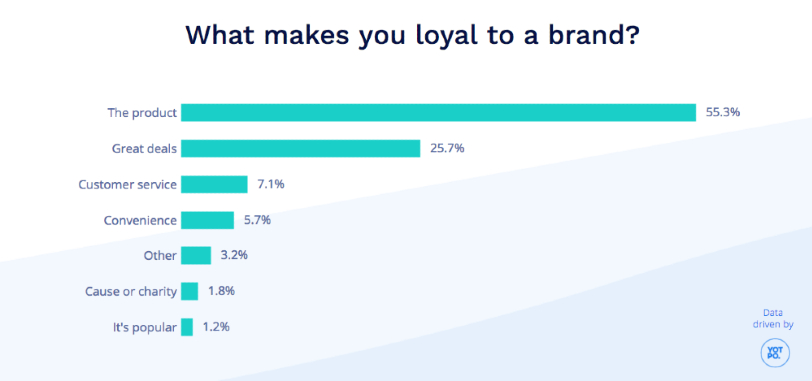
But your product is the greatest factor responsible for making customers loyal to your brand. So, make sure you provide an excellent product.
The biggest achievement here is that the buyers willingly start promoting your products and services. You will get recognition through word of mouth.
It works better than mainstream ads because people put more trust in recommendations they get from friends and families.
You can further optimize this process of promotion by rewarding your customers for recommending you.
For this, you need an effective referral program . Let your loyal customers share the referral links on their social media and receive rewards like gift cards , reward points , gift coupons, etc.
Ultimately, this will help you get buyers that already trust your brand or company before engaging with you and increase your sales.
In the end, your objective is to turn your buyers into promoters for your products and services.
Now, you have to engage with your customers now and make them feel important.
Methods to Use at Promotional Stage
- Use Referral Rewards Program
- Give Exclusive Offers
- Assign Membership
- Personalize services
For example- Adam made several purchases for next few months. He shared referral links on his social media and earned gift coupons. He also talked about the benefits of buying whey protein from bodybuilding.com, which made his gym mates buy from the same e-store.
Okay, you have learned what a buyer’s journey is and what type of content you should use at its different stages but what remains to be discussed is how to use the buyer’s journey or….
Here is an imaginary case study to make you understand the application of the buyer’s journey.
I hope you all enjoy and learn.
Jack is an aspiring athlete and he is performing well. He wants to improve his performance on the track. So, he uses the internet to search for ways to increase his running capacity.
Jack reads an article on fastshoes.com to learn the ways to increase his running capacity and to understand the factors affecting his performance. The blog is of a famous sports goods manufacturer.
There he learns that he needs proper running shoes. He opens a recommended article that says “why proper running shoes are important” and after reading it, he recognizes that all aspects of his training and diet are fine except his running shoes.
Finally, Jack considers buying proper running shoes as he finishes the article. And then, he reads another blog post recommendation titled “Top 10 running shoes 2020.”
He sees the list of running shoes and reads about their individual benefits and decides to buy the most affordable one.
But Jack is conflicted and is having second thoughts. He searches for alternatives and luckily, finds product comparisons available on fastshoes.com.
He learns that his selected running shoes are the best in his preferred price range. Jack makes the final purchase decision. He orders the product and recieves it in a few days.
Jack goes out for a run wearing his new running shoes. He finds his shoes lightweight and comfortable. Jack is able to cover longer distances without fatigue. He is very satisfied with his new running shoes as his performance on the track has improved.
Jack visits fastshoes.com regularly and he also recieves notificiations of the offers and articles relevant to him.
Promotional
Jack’s best friend Dean asks him about the new shoes and Jack explains all the benefits he has received from switching to his new shoes. Dean, impressed by the words of his best friend, goes directly to fastshoes.com and orders the exact same running shoes.
After a year, both Jack and Dean need a new pair of shoes. And they still purchase running shoes from the same eCommerce store.
So, did you notice how Jack went through different stages of the buyer’s journey and became a loyal customer of Fastshoes.com?
It is easy to map out his buying journey from this example. And so, you know what you have to do.
You have to nurture the customer through every stage of the buyer’s journey to make them purchase your product and services. And this is how most businesses are improving their sales.
This research from HubSpot makes it clear that 81% trust their friends and family’s advice over advice from a business.
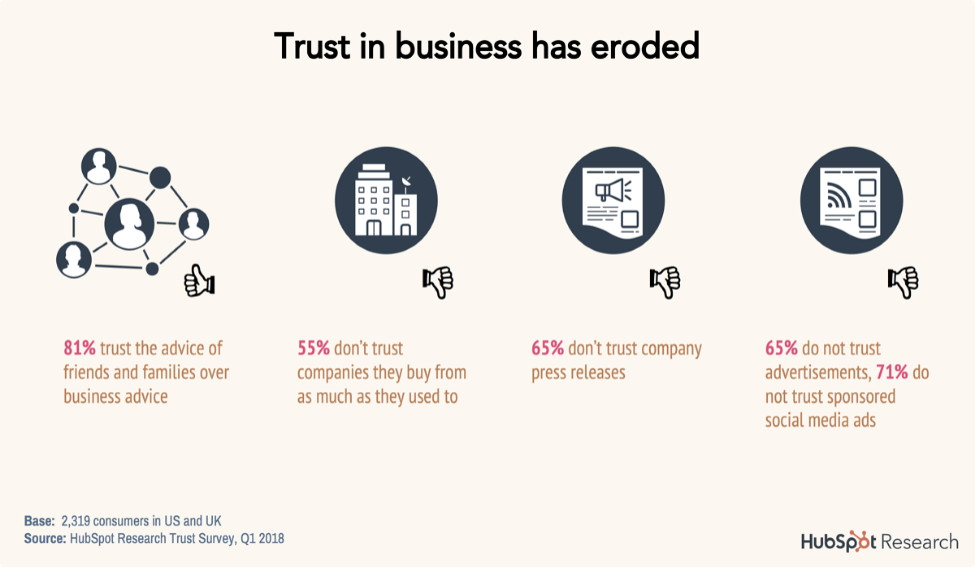
The buyer’s journey is the base of content marketing strategies.
I have explained the buyer’s journey, the use of the content at different stages of the buyer’s journey, and its application with a pretty accurate case study.
You can nurture your customer through every stage of the buyer’s journey and increase your sales with the help of proper application of the concepts explained in this article.
And hey, check out our other blog articles if you want to learn more about best eCommerce practices.
About Aditya Srivastava
Aditya Srivastava is a poet, writer, and avid reader. He lives to write and writes for a living. Coffee is his elixir and books are his best friends. With a tremendous dedication to his craft, he has blurred the line between passion and profession. Like most writers, he is also a powerful thinker but he only thinks with his pen.
Leave A Comment Cancel reply
Save my name, email, and website in this browser for the next time I comment.
Related Posts
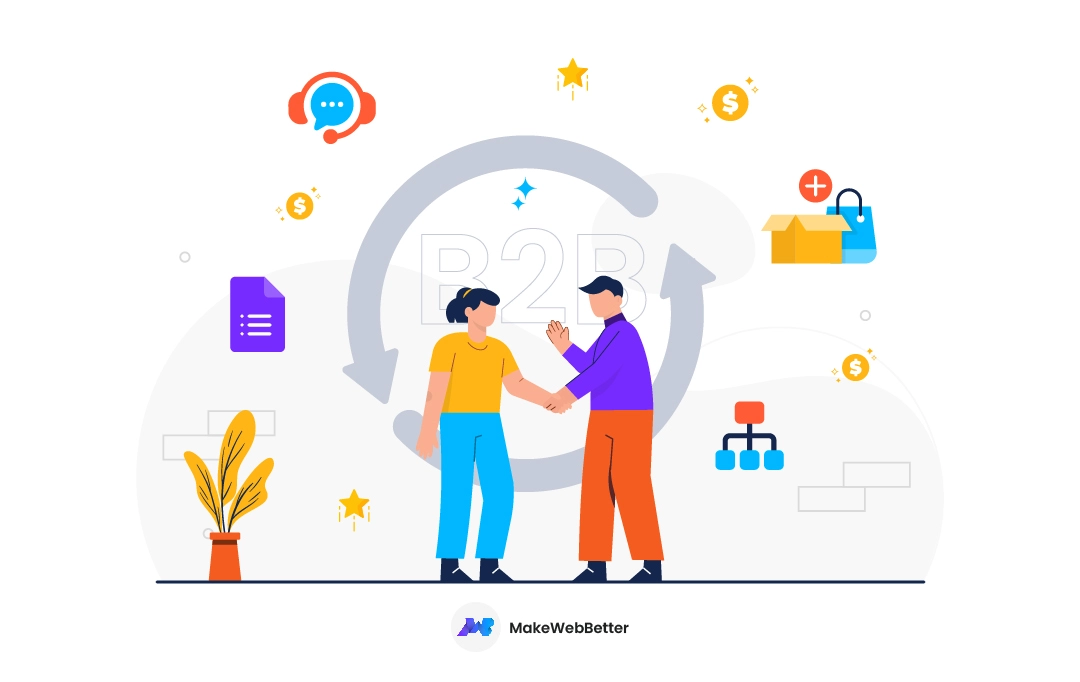
B2B Store Setup With HubSpot: Best Practices & Built-in Tools
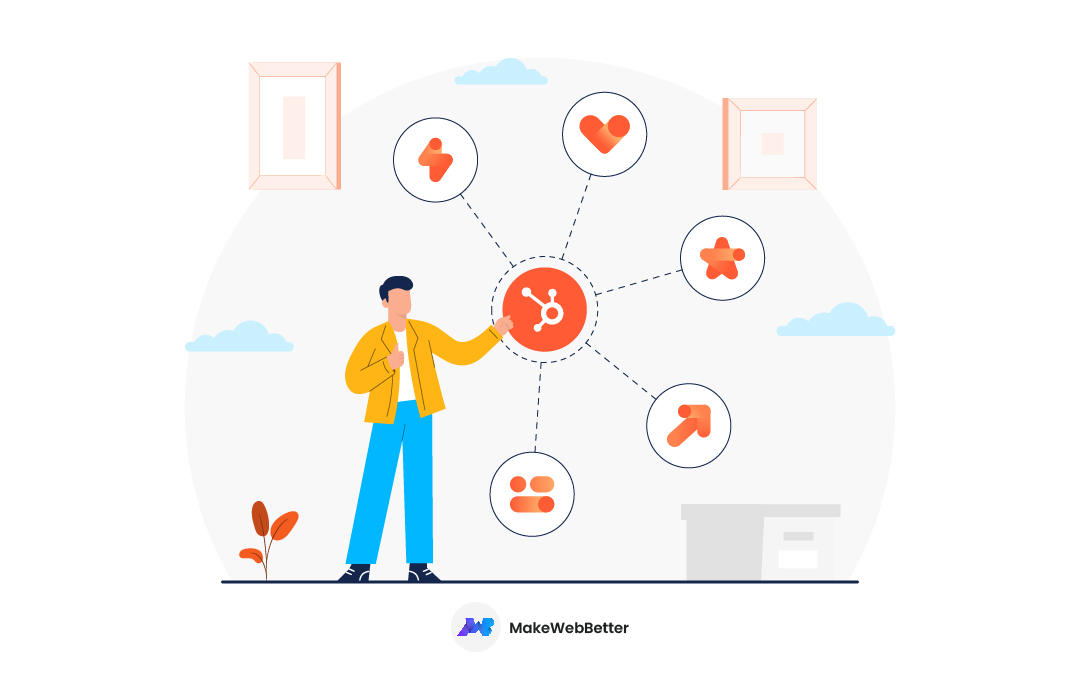
Setting Up Hubspot Integration for eCommerce Businesses
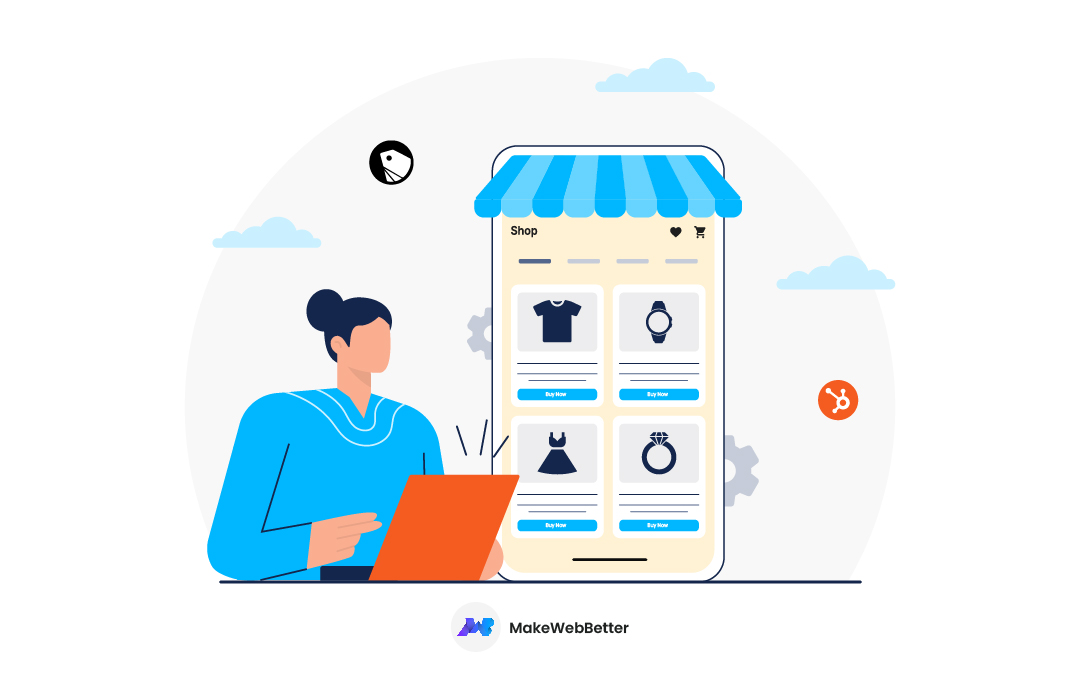
Shopline and Mobile Apps: Your Mobile Shopping Dream Team!

Copyright © 2024 MakeWebBetter . All Rights Reserved.
Privacy Policy | Security
Sales CRM Terms
What is the Buyer's Journey? (Explained With Examples)
Oct 11, 2023

The Buyer's Journey is a crucial concept in the field of marketing. It refers to the process that a buyer goes through when making a purchasing decision. Understanding the buyer's journey is essential for businesses as it helps them create effective marketing strategies to attract and engage potential customers
1°) What is the Buyer's Journey?
The buyer's journey can be defined as the process that a consumer goes through, starting from the awareness stage, where they become aware of a problem or a need, to the decision stage, where they make a purchase decision. This journey can be broken down into different stages, each with its own set of characteristics and goals.
1.1 - Definition of the Buyer's Journey
At its core, the buyer's journey is a framework that helps businesses understand the psychology and behavior of their target audience. It allows them to map out the various stages a typical buyer goes through and tailor their marketing efforts accordingly. By understanding the buyer's journey, businesses can create targeted content and experiences that resonate with potential customers at each stage.
The awareness stage is the first stage of the buyer's journey. During this stage, consumers become aware of a problem or a need that they have. They may start researching and gathering information to better understand their situation. For example, a person who wants to buy a new car may become aware of the need for a more fuel-efficient vehicle.
The consideration stage is the second stage of the buyer's journey. At this stage, consumers have clearly defined their problem or need and are actively seeking solutions. They may compare different options and evaluate the pros and cons of each. Continuing with the previous example, the person in the consideration stage may research different car models and compare their fuel efficiency, features, and prices.
The decision stage is the final stage of the buyer's journey. At this point, consumers have narrowed down their options and are ready to make a purchase decision. They may seek out additional information, such as reviews or testimonials, to validate their choice. Finally, they make a purchase and become a customer. In our example, the person in the decision stage may visit car dealerships, test drive different models, and ultimately choose and purchase a car.
1.2 - Advantages of the Buyer's Journey
The buyer's journey provides several advantages for businesses. Firstly, it allows them to gain insights into the needs, motivations, and pain points of their buyers. This knowledge helps businesses develop targeted marketing messages that address the specific challenges faced by potential customers. For instance, a car manufacturer who understands that their target audience values fuel efficiency can create marketing campaigns highlighting the fuel efficiency of their vehicles.
Secondly, understanding the buyer's journey enables businesses to optimize their sales and marketing strategies to meet the needs of buyers at different stages. By tailoring their messaging and content to each stage, businesses can ensure that they are engaging with customers at the right time and in the right way. This increases the chances of conversion and ultimately leads to more sales.
Finally, the buyer's journey helps businesses build long-term relationships with customers by providing a personalized and seamless buying experience. By understanding the journey, businesses can create a smooth transition from one stage to another, ensuring that customers feel supported and valued throughout their buying process. This can result in customer loyalty and repeat purchases.
1.3 - Disadvantages of the Buyer's Journey
While the buyer's journey offers many benefits, it is not without its limitations. One disadvantage is that not every customer follows the same journey in a linear fashion. Some customers may skip certain stages or move back and forth between stages. This complexity makes it challenging for businesses to create a one-size-fits-all marketing strategy. To address this, businesses may need to create flexible marketing campaigns that can adapt to different customer journeys.
Additionally, the buyer's journey may not capture all aspects of the decision-making process, such as external influences or emotional factors. While the framework provides a valuable structure for understanding customer behavior, businesses should also consider other factors that may influence a customer's decision. This could include factors like social media influence, recommendations from friends and family, or emotional attachments to certain brands.
In conclusion, the buyer's journey is a valuable framework that helps businesses understand and cater to the needs of their customers. By mapping out the different stages and characteristics of the journey, businesses can create targeted marketing strategies that resonate with potential customers at each stage. However, it is important for businesses to recognize the limitations of the buyer's journey and supplement it with additional research and insights to create a comprehensive marketing approach.
2°) Examples of the Buyer's Journey
Now that we have a clear understanding of the buyer's journey, let's explore some real-life examples to illustrate how it works in different contexts.
2.1 - Example in a Startup Context
Imagine a startup that has developed a new productivity app. The buyer's journey for this startup might start with potential customers becoming aware of the app through targeted advertising or word of mouth. The next stage could involve potential customers researching the app's features and benefits, comparing it with competitors, and reading reviews. Finally, the decision stage would involve the potential customers making a purchase or downloading the app and becoming active users. Throughout this journey, the startup would need to provide relevant content and experiences to nurture potential customers and guide them towards making a positive purchasing decision.
2.2 - Example in a Consulting Context
In the consulting industry, the buyer's journey may involve potential clients identifying a problem or opportunity within their organization and seeking solutions. They might start by researching various consulting firms and their expertise. The consideration stage could involve requesting proposals or scheduling consultations with selected firms. Finally, the decision stage would involve the client selecting a consulting firm and signing a contract. Consulting firms need to engage potential clients throughout this journey by showcasing their expertise, providing case studies, and offering personalized recommendations.
2.3 - Example in a Digital Marketing Agency Context
A digital marketing agency's buyer's journey might begin with potential clients recognizing the need for professional marketing services to expand their online presence and attract more customers. The next stage could involve potential clients researching different agencies, exploring their portfolios, and looking for testimonials. In the decision stage, potential clients may request proposals or schedule meetings with selected agencies. The agency's goal would be to establish credibility, showcase successful campaigns, and demonstrate how they can help potential clients achieve their marketing objectives.
2.4 - Example with Analogies
To further illustrate the buyer's journey, let's explore a few analogies. Imagine you are planning a vacation. The awareness stage would involve realizing that you need a break and looking for potential destinations. The consideration stage might involve researching different locations, comparing prices, and reading reviews. Finally, the decision stage would involve booking the trip and making all the necessary arrangements. Similarly, when buying a new car, you go through stages such as researching different models, visiting dealerships, and ultimately making a purchase decision. These analogies highlight how the buyer's journey is a universal concept that applies to various aspects of our lives.
In conclusion, the buyer's journey is an invaluable tool for businesses looking to attract and engage potential customers. By understanding the various stages and characteristics of the buyer's journey, businesses can tailor their marketing strategies to effectively address the needs and motivations of their target audience. Furthermore, real-life examples demonstrate how the buyer's journey can be applied in different contexts. So, whether you're a startup, a consulting firm, or a digital marketing agency, incorporating the buyer's journey into your marketing efforts can lead to increased customer engagement and ultimately drive business success.
About the author

Arnaud Belinga

Close deals x2 faster with
Breakcold sales crm.
SEE PRICING
*No credit card required
Related Articles

What is the 80-20 rule? (Explained With Examples)

What is the ABCD Sales Method? (Explained With Examples)

What is an Accelerated Sales Cycle? (Explained With Examples)

What is Account-Based Marketing (ABM)? (Explained With Examples)

What is an Account Manager? (Explained With Examples)

What is Account Mapping? (Explained With Examples)

What is Account-Based Selling? (Explained With Examples)

What is Ad Targeting? (Explained With Examples)

What is the Addressable Market? (Explained With Examples)

What is the Adoption Curve? (Explained With Examples)

What is an AE (Account Executive)? (Explained With Examples)


What is Affiliate Marketing? (Explained With Examples)

What is AI in Sales? (Explained With Examples)

What is an AI-Powered CRM? (Explained With Examples)

What is an Alternative Close? (Explained With Examples)

What is the Annual Contract Value? (ACV - Explained With Examples)

What are Appointments Set? (Explained With Examples)

What is an Assumptive Close? (Explained With Examples)

What is Automated Outreach? (Explained With Examples)

What is Average Revenue Per Account (ARPA)? (Explained With Examples)

What is B2B (Business-to-Business)? (Explained With Examples)

What is B2G (Business-to-Government)? (Explained With Examples)

What is B2P (Business-to-Partner)? (Explained With Examples)

What is BANT (Budget, Authority, Need, Timing)? (Explained With Examples)

What is Behavioral Economics in Sales? (Explained With Examples)

What is Benchmark Data? (Explained With Examples)

What is Benefit Selling? (Explained With Examples)

What are Benefit Statements? (Explained With Examples)

What is Beyond the Obvious? (Explained With Examples)

What is a Bootstrapped Startup? (Explained With Examples)

What is the Bottom of the Funnel (BOFU)? (Explained With Examples)

What is Bounce Rate? (Explained With Examples)

What is Brand Awareness? (Explained With Examples)

What is the Break-Even Point? (Explained With Examples)

What is a Breakup Email? (Explained With Examples)

What is Business Development? (Explained With Examples)

What are Business Insights? (Explained With Examples)

What is Business Process Automation? (Explained With Examples)

What is a Buyer Persona? (Explained With Examples)

What is the Buying Cycle? (Explained With Examples)

What is a Buying Signal? (Explained With Examples)

What is a Buying Team? (Explained With Examples)

What is a C-Level Executive? (Explained With Examples)

What is Call Logging? (Explained With Examples)

What is Call Recording? (Explained With Examples)

What is a Call-to-Action (CTA)? (Explained With Examples)

What is Case Study Analysis? (Explained With Examples)

What is Challenger Sales? (Explained With Examples)

What is Chasing Lost Deals? (Explained With Examples)

What is Churn Prevention? (Explained With Examples)

What is Churn Rate? (Explained With Examples)

What is Click-Through Rate (CTR)? (Explained With Examples)

What is Client Acquisition? (Explained With Examples)

What is the Closing Ratio? (Explained With Examples)

What is the Ben Franklin Close? (Explained With Examples)

What is Cognitive Bias in Sales? (Explained With Examples)

What is Cognitive Dissonance in Sales? (Explained With Examples)

What is Cold Calling? (Explained With Examples)

What is Cold Outreach? (Explained With Examples)

What is a Competitive Advantage? (Explained With Examples)

What is a Competitive Analysis? (Explained With Examples)

What is Competitive Positioning? (Explained With Examples)

What is Conceptual Selling? (Explained With Examples)

What is Consultative Closing? (Explained With Examples)

What is Consultative Negotiation? (Explained With Examples)

What is Consultative Prospecting? (Explained With Examples)

What is Consultative Selling? (Explained With Examples)

What is Content Marketing? (Explained With Examples)

What is Content Syndication? (Explained With Examples)

What is a Conversion Funnel? (Explained With Examples)

What is Conversion Optimization? (Explained With Examples)

What is a Conversion Path? (Explained With Examples)

What is Conversion Rate? (Explained With Examples)

What is Cost-Per-Click (CPC)? (Explained With Examples)

What is a CRM (Customer Relationship Management)? (Explained With Examples)

What is Cross-Cultural Selling? (Explained With Examples)

What is a Cross-Sell Ratio? (Explained With Examples)

What is Cross-Selling? (Explained With Examples)

What is Customer Acquisition Cost (CAC)? (Explained With Examples)

What is Customer-Centric Marketing? (Explained With Examples)

What is Customer-Centric Selling? (Explained With Examples)

What is Customer Journey Mapping? (Explained With Examples)

What is the Customer Journey? (Explained With Examples)

What is the Customer Lifetime Value (CLV)? (Explained With Examples)

What is Customer Profiling? (Explained With Examples)

What is Customer Retention? (Explained With Examples)

What is Dark Social? (Explained With Examples)

What is Data Enrichment? (Explained With Examples)

What is Data Segmentation? (Explained With Examples)

What is Database Marketing? (Explained With Examples)

What are Decision Criteria? (Explained With Examples)

What is a Decision Maker? (Explained With Examples)

What is a Decision-Making Unit (DMU)? (Explained With Examples)

What is Demand Generation? (Explained With Examples)

What is Digital Marketing? (Explained With Examples)

What is Direct Marketing? (Explained With Examples)

What is a Discovery Call? (Explained With Examples)

What is a Discovery Meeting? (Explained With Examples)

What are Discovery Questions? (Explained With Examples)

What is Door-to-Door Sales? (Explained With Examples)

What is a Drip Campaign? (Explained With Examples)

What is Dunning? (Explained With Examples)

What is an Early Adopter? (Explained With Examples)

What is Elevator Pitch? (Explained With Examples)

What is Email Hygiene? (Explained With Examples)

What is Email Marketing? (Explained With Examples)

What is Emotional Intelligence Selling? (Explained With Examples)

What is Engagement Marketing? (Explained With Examples)

What is Engagement Rate? (Explained With Examples)

What is Engagement Strategy? (Explained With Examples)

What is Feature-Benefit Selling? (Explained With Examples)

What is Field Sales? (Explained With Examples)

What is a Follow-Up? (Explained With Examples)

What is Forecast Accuracy? (Explained With Examples)

What is a Funnel? (Explained With Examples)

What is Gamification in Sales? (Explained With Examples)

What is Gatekeeper Strategy? (Explained With Examples)

What is Gatekeeper? (Explained With Examples)

What is a Go-to Market Strategy? (Explained With Examples)

What is Growth Hacking? (Explained With Examples)

What is Growth Marketing? (Explained With Examples)

What is Guerrilla Marketing? (Explained With Examples)

What is High-Ticket Sales? (Explained With Examples)

What is Holistic Selling? (Explained With Examples)

What is Ideal Customer Profile (ICP)? (Explained With Examples)

What is Inbound Lead Generation? (Explained With Examples)

What is an Inbound Lead? (Explained With Examples)

What is Inbound Marketing? (Explained With Examples)

What is Inbound Sales? (Explained With Examples)

What is Influencer Marketing? (Explained With Examples)

What is Inside Sales Representative? (Explained With Examples)

What is Inside Sales? (Explained With Examples)

What is Insight Selling? (Explained With Examples)

What is a Key Account? (Explained With Examples)

What is a Key Performance Indicator (KPI)? (Explained With Examples)

What is a Landing Page? (Explained With Examples)

What is Lead Database? (Explained With Examples)

What is a Lead Enrichment? (Explained With Examples)

What is Lead Generation? (Explained With Examples)

What is Lead Nurturing? (Explained With Examples)

What is Lead Qualification? (Explained With Examples)

What is Lead Scoring? (Explained With Examples)

What are LinkedIn InMails? (Explained With Examples)

What is LinkedIn Sales Navigator? (Explained With Examples)

What is Lost Opportunity? (Explained With Examples)

What is Market Positioning? (Explained With Examples)

What is Market Research? (Explained With Examples)

What is Market Segmentation? (Explained With Examples)

What is MEDDIC? (Explained With Examples)

What is Middle Of The Funnel (MOFU)? (Explained With Examples)

What is Motivational Selling? (Explained With Examples)

What is a MQL (Marketing Qualified Lead)? (Explained With Examples)

What is MRR Growth? (Explained With Examples)

What is MRR (Monthly Recurring Revenue)? (Explained With Examples)

What is N.E.A.T. Selling? (Explained With Examples)

What is Neil Rackham's Sales Tactics? (Explained With Examples)

What is Networking? (Explained With Examples)

What is NLP Sales Techniques? (Explained With Examples)

What is the Net Promotion Score? (NPS - Explained With Examples)

What is Objection Handling Framework? (Explained With Examples)

What is On-Hold Messaging? (Explained With Examples)

What is Onboarding in Sales? (Explained With Examples)

What is Online Advertising? (Explained With Examples)

What is Outbound Sales? (Explained With Examples)

What is Pain Points Analysis? (Explained With Examples)

What is Permission Marketing? (Explained With Examples)

What is Personality-Based Selling? (Explained With Examples)

What is Persuasion Selling? (Explained With Examples)

What is Pipeline Management? (Explained With Examples)

What is Pipeline Velocity? (Explained With Examples)

What is Predictive Lead Scoring? (Explained With Examples)

What is Price Negotiation? (Explained With Examples)

What is Price Objection? (Explained With Examples)

What is Price Sensitivity? (Explained With Examples)

What is Problem-Solution Selling? (Explained With Examples)

What is Product Knowledge? (Explained With Examples)

What is Product-Led-Growth? (Explained With Examples)

What is Prospecting? (Explained With Examples)

What is a Qualified Lead? (Explained With Examples)

What is Question-Based Selling? (Explained With Examples)

What is Referral Marketing? (Explained With Examples)

What is Relationship Building? (Explained With Examples)

What is Revenue Forecast? (Explained With Examples)

What is a ROI? (Explained With Examples)

What is Sales Automation? (Explained With Examples)

What is a Sales Bonus Plan? (Explained With Examples)

What is a Sales Champion? (Explained With Examples)

What is a Sales Collateral? (Explained With Examples)

What is a Sales Commission Structure Plan? (Explained With Examples)

What is a Sales CRM? (Explained With Examples)

What is a Sales Cycle? (Explained With Examples)

What is a Sales Demo? (Explained With Examples)

What is Sales Enablement? (Explained With Examples)

What is a Sales Flywheel? (Explained With Examples)

What is a Sales Funnel? (Explained With Examples)

What are Sales KPIs? (Explained With Examples)

What is a Sales Meetup? (Explained With Examples)

What is a Sales Pipeline? (Explained With Examples)

What is a Sales Pitch? (Explained With Examples)

What is a Sales Playbook? (Explained With Examples)
Try breakcold now, are you ready to accelerate your sales pipeline.
Join over +1000 agencies, startups & consultants closing deals with Breakcold Sales CRM
Get Started for free
Sales CRM Features
Sales CRM Software
Sales Pipeline
Sales Lead Tracking
CRM with social media integrations
Social Selling Software
Contact Management
CRM Unified Email LinkedIn Inbox
Breakcold works for many industries
CRM for Agencies
CRM for Startups
CRM for Consultants
CRM for Small Business
CRM for LinkedIn
CRM for Coaches
Sales CRM & Sales Pipeline Tutorials
The 8 Sales Pipeline Stages
The Best CRMs for Agencies
The Best CRMs for Consultants
The Best LinkedIn CRMs
How to close deals in 2024, not in 2010
CRM automation: from 0 to PRO in 5 minutes
LinkedIn Inbox Management
LinkedIn Account-Based Marketing (2024 Tutorial with video)
Tools & more
Sales Pipeline Templates
Alternatives
Integrations
CRM integration with LinkedIn
© 2024 Breakcold
Privacy Policy
Terms of Service

Wat is de buyer journey
De buyer journey of klantreis is de reis die een potentiële klant maakt om uiteindelijk een klant bij jouw bedrijf te worden.
De buyer journey heeft daarbij niet alleen betrekking op de kanalen die je kiest, maar ook op de inhoud van je boodschap in elke fase van het proces. Door deze klantreis in kaart te brengen kun je hier met je communicatie beter op inspelen en uiteindelijk meer leads genereren.
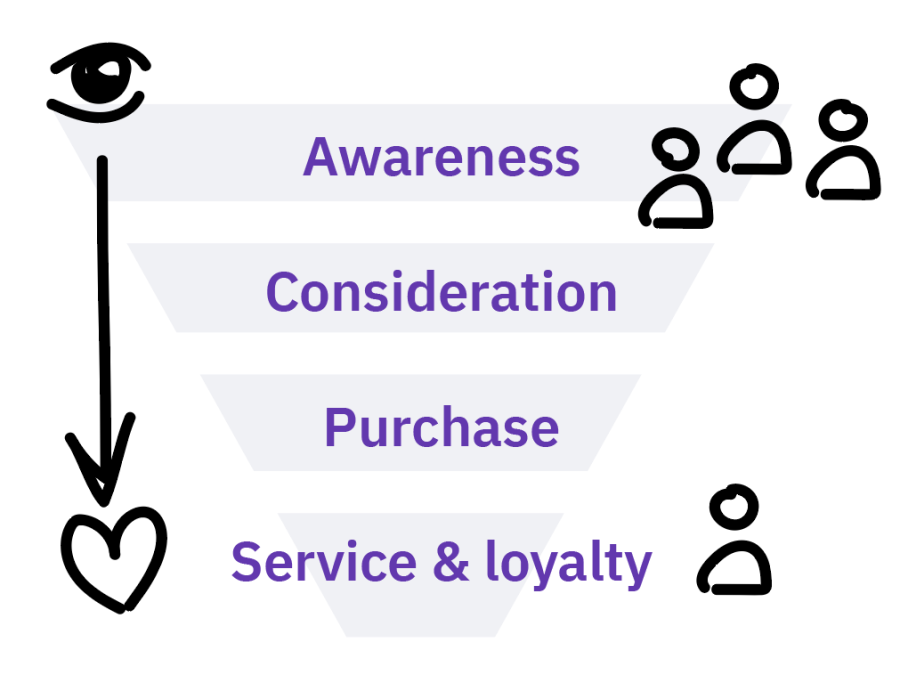
Buyer journey: 3 onderdelen
In het buyer journey model worden drie verschillende fases van het koopproces belicht. In iedere fase vertoont de klant een ander gedrag.
1. Awareness – Bewustwording
De eerste fase in de buyer journey is dat potentiële klanten bewust worden dat zij behoefte hebben aan een bepaalde dienst of product voor een probleem. Vaak zijn zij nog niet bekend met je bedrijf, product of dienst.
In deze fase ga potentiële klanten activeren door jezelf bij hen onder de aandacht te brengen. Dit kan door te adverteren via social media, Google AdWords of offline kanalen als print. In deze advertenties verwijs je naar informatie die je potentiële klanten helpt hun probleem op te lossen.
2. Consideration – Overweging
In deze fase zijn potentiële klanten zich inmiddels bewust geworden van hun probleem en oriënteren zij zich op mogelijke oplossingen. Potentiële klanten gaan zich verdiepen in hun probleem en overwegen wie hen daarbij kan helpen.
Je moet dan ook duidelijk zijn wat je aanbiedt en hoe jouw bedrijf kan helpen bij de problemen van je potentiële klanten. In deze fase is het van belang om de meerwaarde van je bedrijf onder de aandacht te brengen en het vertrouwen van de potentiële klant te winnen. Dit doe je door uit te leggen hoe jouw dienst of product werkt en waarom mensen voor jou zouden moeten kiezen. Voeg daar ook een duidelijke call to action toe.
Onze video legt bijvoorbeeld uit hoe onze diensten bedrijven kunnen helpen en wat ons onderscheidt:
Wanneer potentiële klanten een of meerdere oplossingen gevonden hebben is zullen zij een overweging maken wat voor hen de beste oplossing is en daarbij ook rekening te houden met extra zaken als kosten en service. Probeer dit voor hen zo duidelijk mogelijk te maken door de verschillen tussen jou en je concurrenten toe te lichten.
Een andere vorm om potentiële klanten te overtuigen zijn ervaringen of beoordelingen door mensen of bedrijven die je dienst/product eerder hebben afgenomen. Probeer in dat geval duidelijk naar voren te laten komen waarom deze klanten jou hebben gekozen boven de concurrentie.
Daarnaast is het ook in deze fase van belang om online goed zichtbaar te zijn, zodat je niet alleen gevonden wordt door potentiële klanten maar ook aan vertrouwen en autoriteit wint. Wanneer je bijvoorbeeld hoog in de organische zoekresultaten staat op de vraag die je potentiële klant stelt, zal dit bijdragen aan het vertrouwen.
3. Purchase – Aankoop
De potentiële klant is overgegaan tot de aankoop van je product of dienst. In deze fase is het belangrijk dat het aankoopproces goed, eenvoudig en soepel verloopt.
Zorg ervoor dat mensen snel je producten- of dienstenaanbod weten te vinden op je website en dat het bestelproces eenvoudig en soepel is.
Bonus: gratis ebook over leadgeneratie
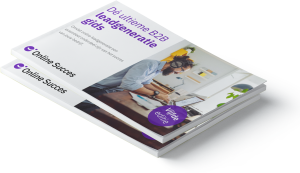
Alles weten over leadgeneratie? Download dan ons gratis ebook en leer hoe je leads genereert én opvolgt in een zakelijke markt. Het is ons meest gelezen ebook en in 2022 compleet herschreven voor de 5e editie.
Download ebook direct »
Nieuw hier?
- Wat is Online Succes
- Lees onze blogs
Oplossingen
- Voor marketeers
- Voor salesteams
- Helpcentrum
- Product Updates
- Partnerprogramma
- Ons verhaal
- Werken bij Online Succes
Begrippenlijst
- b2b leadgeneratie
- website leads
Maak van je website een nieuw leadkanaal.
- Brand Development
- Case Studies
- Digital Marketing
- Graphic Design
- Search Engine Optimization
- Social Media
- Web Development
What is a buyer journey? And how can you use it in your marketing strategies?

What is a buyer journey, and why is it important?
- Awareness
- Consideration
Awareness phase

Buyer journey example: the awareness phase
Consideration phase.

Buyer journey example: the consideration phase
Decision phase.

Buyer journey example: the decision phase
How to use the buyer journey to shape your marketing strategy.
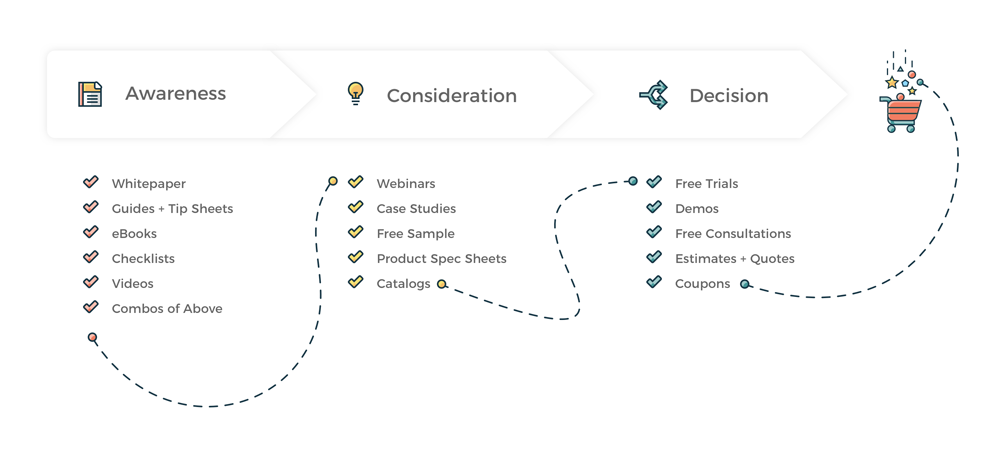
Awareness phase marketing
Consideration phase marketing, decision phase marketing.
- Are you using video to enhance your buyer journey?
- Focused marketing campaigns: buyer personas
- The middle funnel conundrum
- 8 ideas for planning better digital marketing for your company in 2018

About the author | TBH Creative
TBH Creative is an award-winning marketing company specializing in web design/development, digital strategy, inbound marketing, and reporting. Since 2004, we’ve built multi-dimensional digital marketing campaigns and complex, enterprise-level websites for clients in a wide range of industries.
We believe in communicating clearly, delivering excellence, and beating deadlines. But beyond those ideals, what really drives the heart of our business is your business—helping our clients achieve more with comprehensive digital marketing and web design.
Our Indianapolis web design company is WBE-certified in the state of Indiana and the city of Indianapolis, and we’re also a Hubspot-certified inbound marketing agency.
View more posts by TBH Creative
Try changing your search query or try one of the suggestions below!
War in ukraine, free and up-to-date :), transportation to and from moscow sheremetyevo airport, what is the distance from moscow sheremetyevo airport to the centre of moscow.
The distance to the centre of Moscow (Saint Basil’s Cathedral / Red Square) is 34 kilometres from South Terminal Complex and 42 kilometres from North Terminal Complex. Thus, terminals A and B are further away from the city. Travel time between the airport and the city centre is 1 hour and 5 minutes. Unfortunately, it can be busy on the roads and you should take into account a car journey that takes longer.
From SVO Airport to Moscow City centre by Taxi
City centre
Public transport
Train aeroexpress to moscow – buy tickets.
The fastest travel option between Moscow Sheremetyevo Airport and the centre of Moscow is the train Aeroexpress. You can get stuck in a traffic jam if you travel by car, taxi or bus, that won’t happen if you take the train. The Aeroexpress commutes between Belorussky Station in the city and the railway station at the airport, located on the south side of the airport at Terminal E. An automated people mover (APM) runs between this station and terminals A and B. The Aeroexpress departs every 30 minutes, travel time is 35 minutes.
From metro station Belorusskaya at Belorussky Station, you can travel by metro to the city centre and other parts of Moscow. The journey time from metro station Belorusskaya to metro station Teatralnaya close to Red Square is only 5 minutes.
Aeroexpress tickets The prices are listed below, an Aeroexpress ticket including a ride with the metro, tram or (trolley) bus costs 560 RUB, the price for a subway ticket is 55 RUB. You can buy tickets for the Aeroexpress at the stations, but it is cheaper to do this online. Please consult website and timetable Aeroexpress for more information.

SAVING TIPS: Tickets can be bought at the airport, but online it is easier and cheaper (450 RUB one way, 900 RUB return). A group ticket can be used by four people and costs 1,100 RUB for a single journey and 1,800 RUB for a return (valid for 30 days). The price is the same online and from the ticket machine. Aeroexpress trains run without stopping, besides you can use free WiFi aboard since early 2015.
Top 5 sights in Moscow
1. Red Square – free! 2. Moscow Kremlin 3. Saint Basil’s Cathedral 4. Moscow Metro Tour of 1.5 hours 5. Communist Walking Tour of 2 hours
Bus and metro to Moscow
It is more economical to travel by bus and metro to the centre of Moscow. Needless to say, taking a direct train is easier and faster. With bus 817 and bus 948 you can get in 35 minutes to metro station Planernaya (northernmost station metro line 7). With bus 851 and bus 949 it takes 25 minutes to metro station Rechnoy Vokzal (northernmost station metro line 2). The price of a bus ticket is 57 RUB or 80 RUB.
From both stations you can take the metro to the centre of Moscow, station Kuznetskiy Most for metro line 7 (travel time: 31 minutes) and station Teatralnaya for metro line 2 (travel time: 23 minutes). Metro station Kuznetskiy Most is a short distance from the world-famous Bolshoi Theatre. The total journey time is at least one hour. If the bus ends up in a traffic jam, the journey can take a lot longer.
Tickets for the subway priced 55 RUB are available from the ticket vending machines. You can also buy a day ticket (yediniy) for public transport in Moscow for 200 RUB, it is valid for 24 hours. During the night you can travel by bus H1 between the airport and the city every half hour. Please consult buses to and from Moscow Sheremetyevo Airport and website Moscow Metro for more information.
“The metro stations with the most central location in Moscow are Okhotny Ryad (M1), Teatralnaya (M2) and Revolution Square (M3), at a short distance from Red Square, Kremlin and GUM.”
Discover and book tickets, activities and tours:
Prague: the best of mozart with opera and ballet.
Enjoy an evening in lavish style listening to a Concertino Prague Orchestra in the historical Smetana Hall. Relax as you listen to music by Mozart and marvel at the talented musicians and dancers.
Sydney: Kandinsky Exhibition at the Art Gallery of NSW
Experience a showcase of the life and work of Kandinsky, one of the most influential and best-loved European modernists at the must-see Art Gallery of New South Wales.
Yerevan: Self-Guided Tour for your Audio Device with Map
Explore the city of Yerevan on a self-guided audio tour. Dive into sights like the Sculpture Park, Republic Square, and the Cascade staircase with facinating audio commentary.
Belgrade 20th century tour
Get to know history and architecture of turbulent period in Serbian development. The most important sights and attractions from the last century.
Budapest: Private Communism Walking Tour with Museum Entry
Learn about everyday life in Budapest during the days of communism, when people drove Trabant cars and drank spirits at work. Hear about the black market and the infamous queues to buy bananas, and visit sites where revolutionary action took place.
Evening Walking Yerevan City Tour with 3 Brandy & Gata
3 types of Armenian brandy and sweet pastry Gata you need to taste in Yerevan. Welcome to our city of sun! The largest and capital city of the Republic of Armenia is Yerevan-the city older than Rome.
Tours and transport
Behind the iron curtain of tallinn - secrets of the soviets.
Get to know the Soviet history of Tallin. Visit an abandoned Soviet air defense base and find out about the former border-zone areas in Tallinn.
Riga Highlights bike tour
Explore Riga's top sights on this guided bicycle tour. Get out of the Old Town and experience beautiful parks, the Jewish Ghetto, the fascinating Moscow suburb, and see the Art Nouveau district.
Warsaw: Private 3-Hour Tour by Car with Hotel Pickup
Discover the past and present of Warsaw on a private 3-hour tour. Learn more about the history of the city and its dynamic development. See the Royal Route, Łazienki Park, and palace complex.
★★★☆☆ 2 reviews
Have you visited Moscow Sheremetyevo Airport lately? So far, 2 airport passengers have written an airport review about Moscow Sheremetyevo Airport. This airport has an average score of 3 out of 5. Provide other airport travellers with essential airport information and tell us about your airport experience.
Write a review

IMAGES
VIDEO
COMMENTS
De buyer journey is het proces dat een potentiële klant doorloopt op weg naar een aankoop. Het belangrijkste uitgangspunt hierbij is dat de behoeften en vragen van de koper veranderen tijdens de verschillende fasen van dit koopproces. Het buyer journey model komt voort uit de content marketing en is later ook geadopteerd in de inbound ...
Het stadium van bewustwording. In het eerste stadium van de buyer's journey gaat het om de pijnpunten van de potentiële klant. In het stadium van bewustwording weet de mogelijke koper dat er een probleem is dat een oplossing nodig heeft. Bijvoorbeeld een jogger wiens koptelefoon tijdens het sporten steeds uit zijn oor valt.
De reis van de koper is het proces dat kopers doorlopen om zich bewust te worden van een nieuw product of dienst, deze te evalueren en te kopen. Een buyers journey is anders dan een customer journey. Een customer journey gaat over de reis van de klant. Er wordt omschreven hoe iemand klant is geworden, hoe ze bekend zijn geraakt met het bedrijf ...
The buyer's journey describes a buyer's path to purchase. In other words, buyers don't wake up and decide to buy on a whim. They go through a process to become aware of, consider and evaluate, and decide to purchase a new product or service. By understanding the buyer's journey, the pains and problems they experience along that journey, and the ...
Definition, stages, and examples. January 4, 2024. 5. ( 1) Step into the realm where choices weave the intricate fabric of consumer decisions — the buyer journey. As we navigate this landscape, we'll uncover the definition, stages of such a journey, and real-world examples that demystify the process. Join us on this expedition — no fluff ...
This journey is typically segmented into three stages: awareness, consideration, and decision. Don't assume, however, that every buyer steps through those three stages in 1-2-3 order every time. Buyers' journeys often wind up taking very non-linear paths. We'll get into that below.
The buyer's journey is a framework for thinking about the stages that a buyer goes through in the complex purchase typical in B2B. It allows sellers to arrange their tactics to best help their buyers navigate each of those stages and to measure their effectiveness at creating advantage as they do. Summarised as awareness, consideration, and ...
The Buyer's Journey: A Comprehensive Guide for Marketers and Sales Professionals. Nov 23 2023. by Kapil Khangaonkar. As marketers and sales professionals, understanding the buyer's journey is essential for successfully guiding potential customers towards a purchase decision. The buyer's journey is a three-step process that begins with awareness ...
The buyer's journey primarily focuses on the path a customer takes from the initial stage of identifying a problem or need, through the evaluation of solutions, to the final purchase decision. It centers on the pre-purchase stages of the customer's experience. In contrast, the customer journey encompasses the entire end-to-end experience a ...
The Buyer's Journey can be defined as the process or stages a potential customer goes through from discovering a brand to making the final purchase. It's a path guided by the brand's unique voice and identity that resonates with customers at each stage. Buyer's journey stages are often categorized into three primary types - Awareness ...
November 7, 2023. It's about the journey, not the destination. Understanding buyer journey stages empowers marketers to deliver the right message at the right time. Using buyer journey stages as part of a greater marketing strategy is like having a treasure map that guides brands toward measurable success, one stage at a time.
The buyer journey mapping above shows the three stages of the buyer journey i.e. awareness, consideration, and conversion (acquisition). It highlights what the prospects want to achieve, their thought, actions, feeling, pain points, and opportunities. It is a complete buyer journey mapping. 2.
According to HubSpot, the buyer's journey is the process buyers go through to become aware of, consider, and evaluate, and decide to purchase a new product or service. This definition tells us that there are three stages of the buyer's journey: Awareness. Consideration. Decision.
Stages, Examples, and More. The buyer's journey is the process potential customers go through to decide to buy a product or service. Although there are usually similarities, every buyer's journey is different and can take many twists and turns. It's imperative to develop an online marketing strategy that includes creating compelling ...
1.1 - Definition of the Buyer's Journey. At its core, the buyer's journey is a framework that helps businesses understand the psychology and behavior of their target audience. It allows them to map out the various stages a typical buyer goes through and tailor their marketing efforts accordingly. By understanding the buyer's journey, businesses ...
Buyer journey: 3 onderdelen. In het buyer journey model worden drie verschillende fases van het koopproces belicht. In iedere fase vertoont de klant een ander gedrag. 1. Awareness - Bewustwording. De eerste fase in de buyer journey is dat potentiële klanten bewust worden dat zij behoefte hebben aan een bepaalde dienst of product voor een ...
Buyer journey definition. The buyer journey is a path your customer takes from the early stages of understanding his or her problem before ultimately making a decision to hire your company or purchase a product from your company. You can use the buyer journey as an analysis tool you can use to enhance your marketing to help customers work ...
Home & Family Main-> Home & Family. Adoption Agencies
SAVING TIPS: Tickets can be bought at the airport, but online it is easier and cheaper (450 RUB one way, 900 RUB return). A group ticket can be used by four people and costs 1,100 RUB for a single journey and 1,800 RUB for a return (valid for 30 days). The price is the same online and from the ticket machine.
Federal Land Cadastre Service of Russia Federal Land Cadastre Service of Russia (former RF Goskomzem) is a federal executive authority responsible for land administration including state land cadastre maintenance and recording of real estate units attached to land parcels, land use planning, state cadastre land valuation, land monitoring and state inspection of land use and protection.
ordinance no.2o2o - 03 an ordinance of the city of moscow, idaho, a municipal corporation of the state of idaho for revising, codifying and compiling the general ordinances of the city of moscow; providing for the enactment of anew chapter 11 to title 1, of moscow city code entitled emergency powers; setting forth the authority; purpose and intent; ...